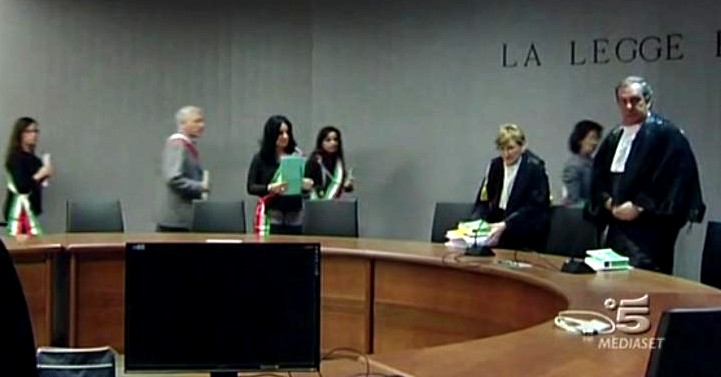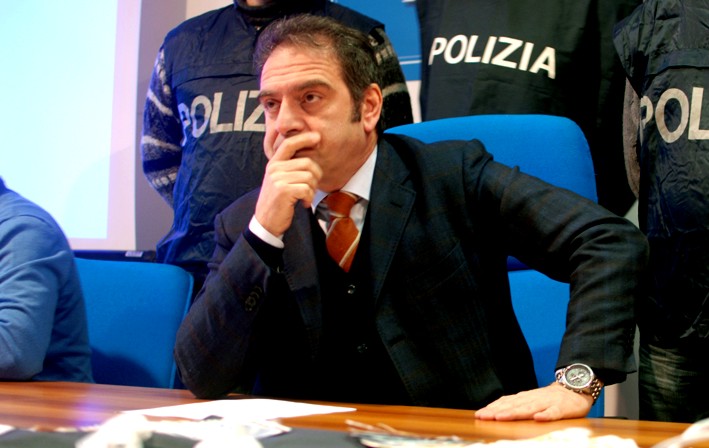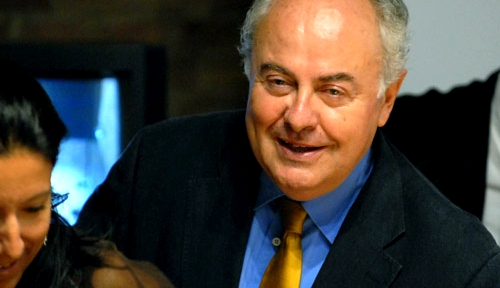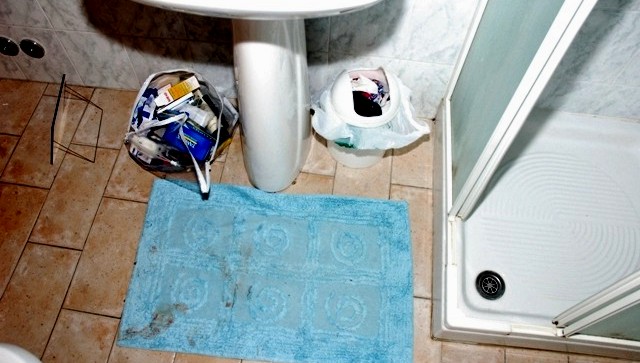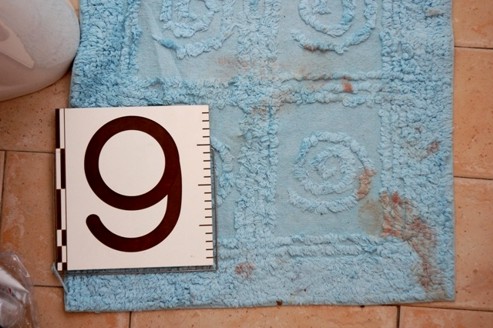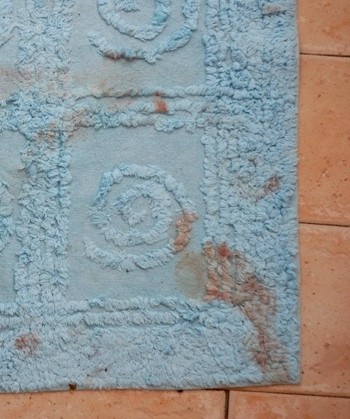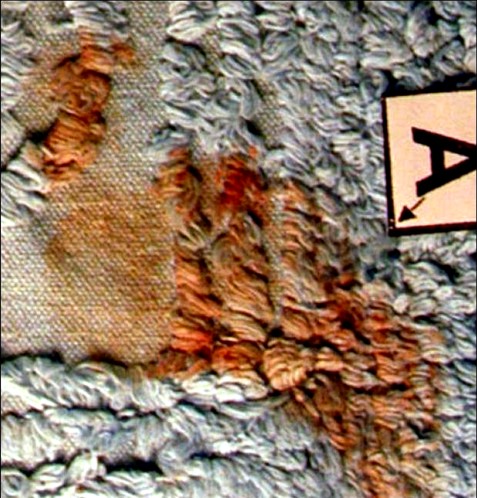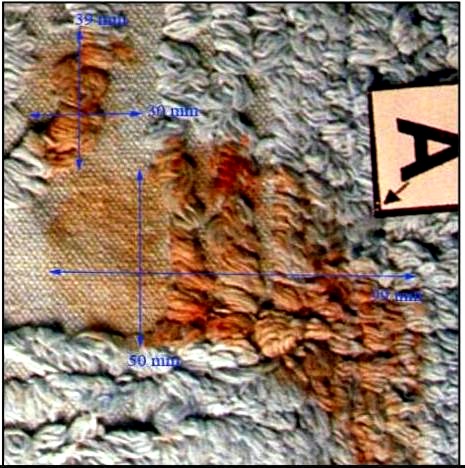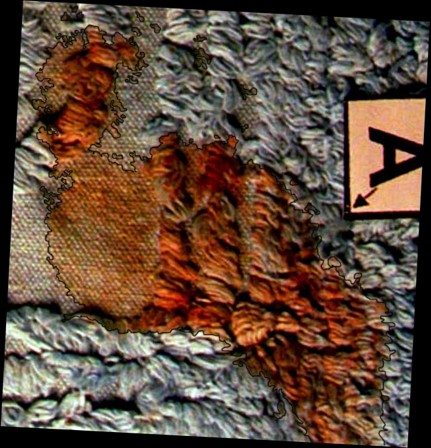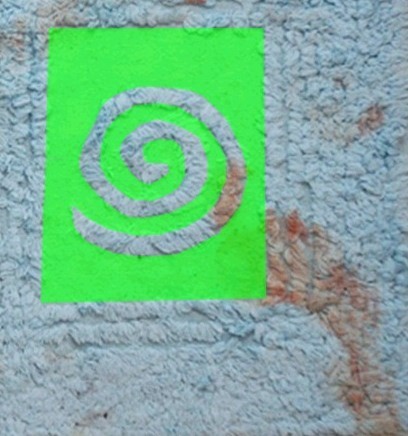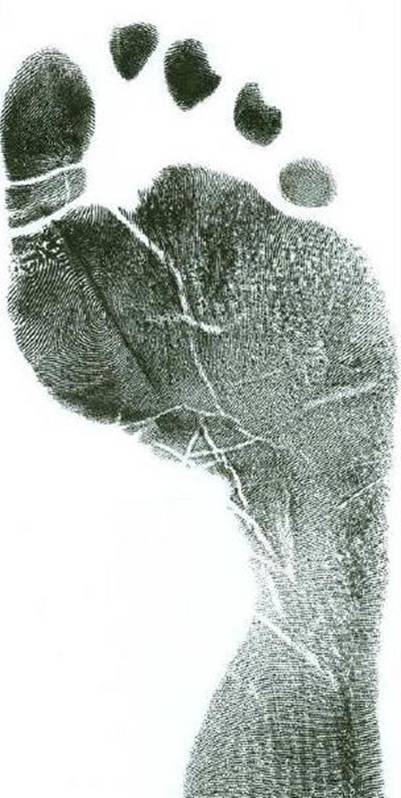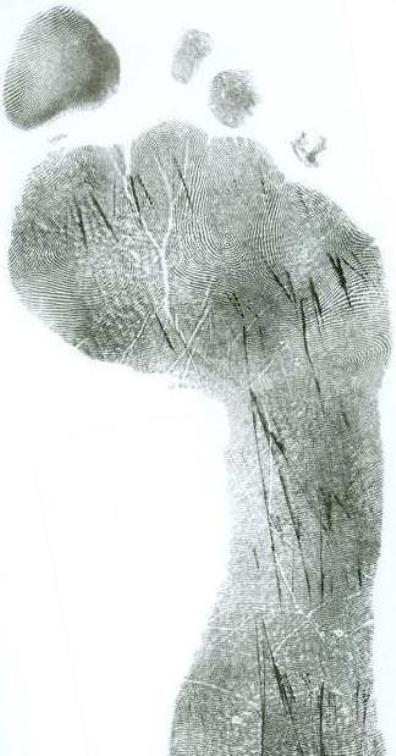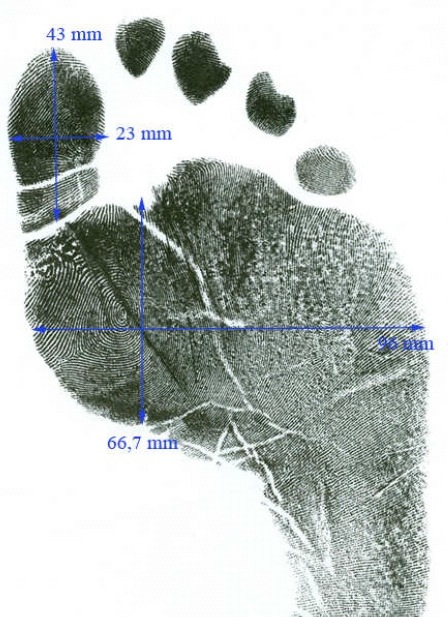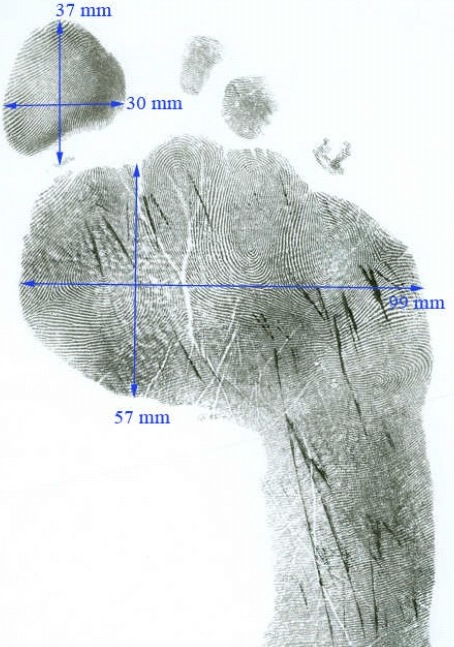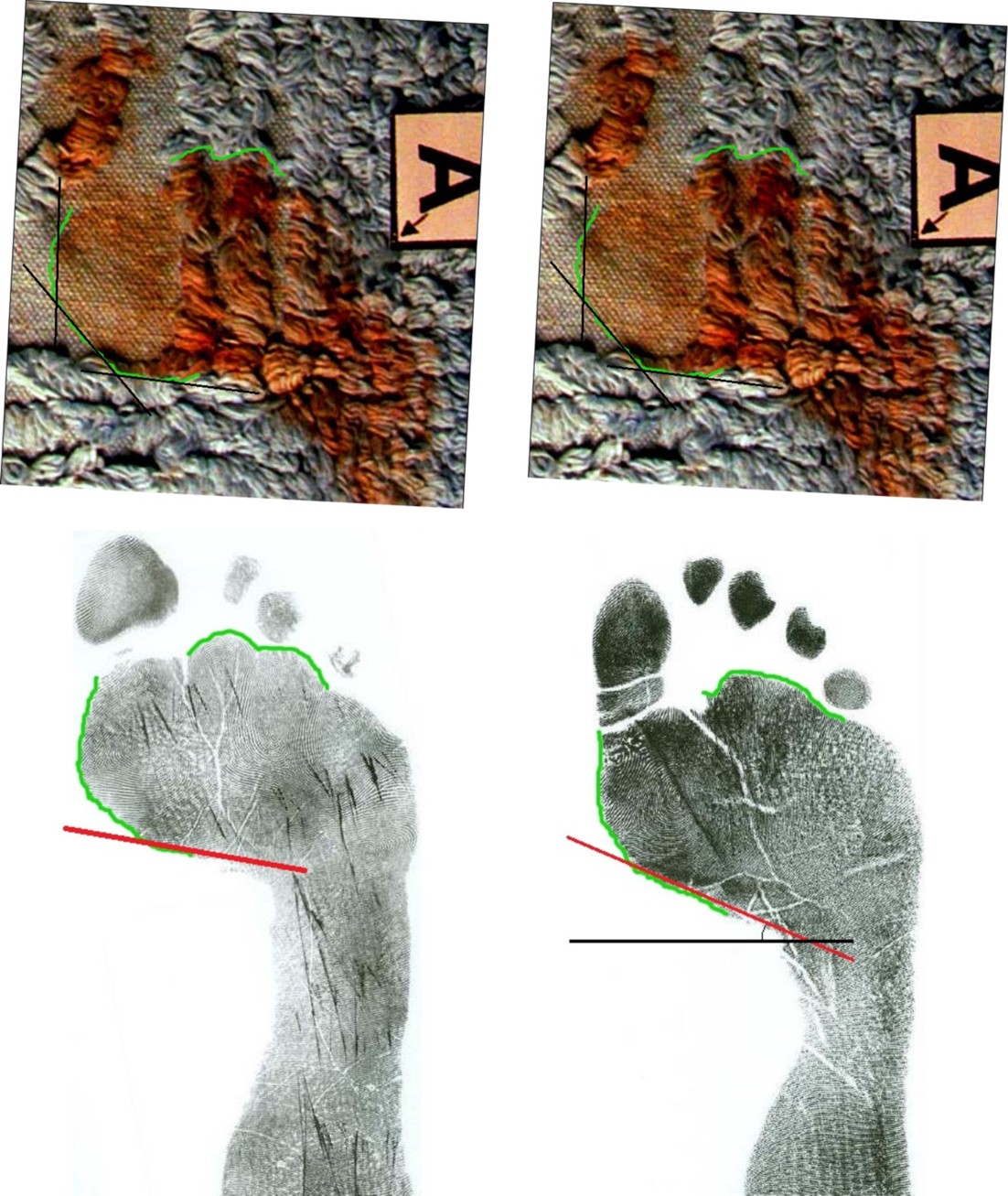
Category: Trials 2008 & 2009
Saturday, November 15, 2014
The Status Of The Various Computers In The Case #2 New Developments
Posted by Sallyoo
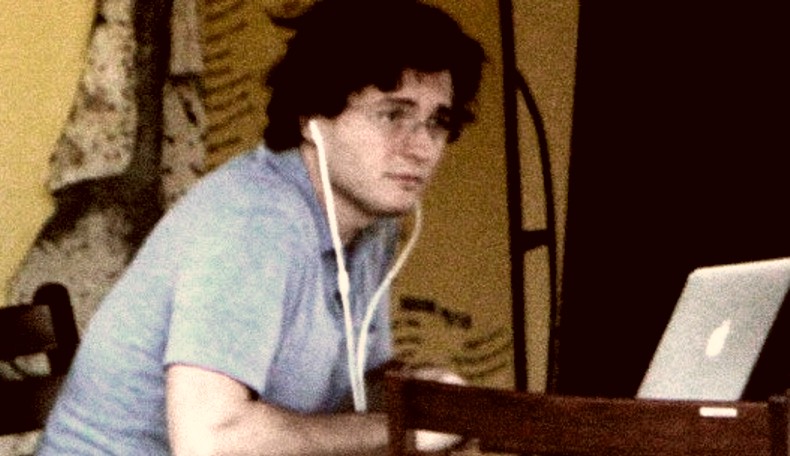
Please first see my previous post and my several updates in the Comments thread.
There has been a new flurry of interest in Raffaele’s computers following the publication, on iip, of a report prepared by Prof. Alfredo Milani. It is available in both in Italian and English, (translation prepared by iip.)
The report isn’t dated, but it was prepared after the Massei report had been published, and it was taken into evidence at the Hellmann appeal. Milani credits another defence computer expert, D’Ambrosio, with a lot of the content.
There have been (to my knowledge) three “˜defence computer expert reports’ prepared. The first, signed by Angelucci in March 2008, is concerned primarily with the damaged hard disks of the Asus of Sollecito, and the computers of Meredith Kercher and Amanda Knox. This report was commissioned by Dalla Vedova and has not (as far as I can determine) ever been taken into evidence, or even mentioned in court.
The salient point in this document is that the data was recovered from the disks of Sollecito’s Asus and Meredith Kercher’s computer.
Then we have D’Ambrosio testifying at Massei (available), accompanied by a report written by D’Ambrosio and Gigli taken into evidence (not available).
At Hellmann we have the Milani report. Raffaele mentions Alfredo Milani in his book as one of his professors.
There isn’t a lot of (strictly computer) information in it which goes beyond D’Ambrosio’s testimony, although the tone is very different. While D’Ambrosio was relatively generous to the police computer analysts, appreciating the procedural retrictions which they worked under, Milani gets close to being offensively insulting to those tehnicians. (Compare with the Conti/Vecchiotti tactics”¦)
Milani attempts to make us believe that two “˜grave methodological errors’ committed by the postal police have concealed data which would provide an alibi.
Firstly he spends much time outlining the MacOS, in every release, and tells us that because the postal police used an “˜analogous but not identical’ MacBook a tiny difference in the release number of the operating system renders their analysis unreliable. This is impossible to acept for two reasons - firstly that the OS employed resided on the cloned disk from Sollecito’s own MacBook, but more importantly the precise OS release would not affect in any way the reading of the log files.
Secondly, he unwisely reminds us of inodes (log files). These files are regularly archived, in compressed form, and this archive is not overwritten. The archive isn’t very simple for an ordinary user to search, but such a search is certainly within the capabilities of an “˜expert computer consultant’. If Milani had discovered anything - such as a use of the Samba utility via the Asus which would have been recorded - he would have told us about it.
He also includes some gratuitous comments - which are rather fun - so we can move onto those now!
Milani has trawled up a keyboard interaction (on Sollecito’s Mac), at 22.04 on November 5, when he assures us that Sollecito was in the questura. Well, every other piece of evidence has Sollecito not arriving at the questura that evening until at least 22.30 - but Raffaele has always claimed to have been eating with a friend when he received the phone call at 21.30 asking him to attend the questura. Was Sollecito at Riccardo’s? Did he nip home (why) before going to the questura? We shall never know, but Milani has given us reason to speculate.
He also offers us the playlist of the music tracks both listened to and skipped between 05.40 and 06.20 (approx) on the morning of Nov 2 - which for some reason he erroneously asserts that the postal police failed to identify as an interaction. You can form your own opinion on the musical taste of the listeners, Nirvana and Bon Jovi feature.
Additionally we learn that one of the films “˜recently viewed’ was Suicide Club, a Japanese cult movie, which can charitably be described as Extreme Fantasy. We also discover that in the CD drive was music from Blind Guardian - a German heavy metal band who used fiction/fantasy themes in their lyrics. (I am left with the impression that Sollecito and Knox were determined not to live in the real world during this period).
A further couple of snippets, the first from an intercepted conversation in prison between Raffaele, his father and his stepmother, Marisa Papigni:
FS:....have nothing to do with [rude in italian] ... and they understood ... now this morning or Monday there will be also the checking of your computer ... they have already cloned the hard disk .. “
RS: “”¦ my concern of the computer is basically that if I came ...”
Marisa Papagni: “Hey ... there is a monster on your computer ... there is a monster ... “
RS: “Forget it ... the fact about the computer is if I have spent much time with Amanda ... there is not all this time I have spent with the computer ...”
FS: “If Amanda was home ... if she was out, wtf were you doing? ... were you at the computer?” .....
And from Honor Bound:
Papà told him about the data from my computer”¦.but still Maori was skeptical. “Why don’t you let me see it?” he asked.
My father didn’t have the data with him, but he said his brother, Giuseppe, could fax it over.
Below: Professor Milani; Perugia University School of Mathematics & Computers
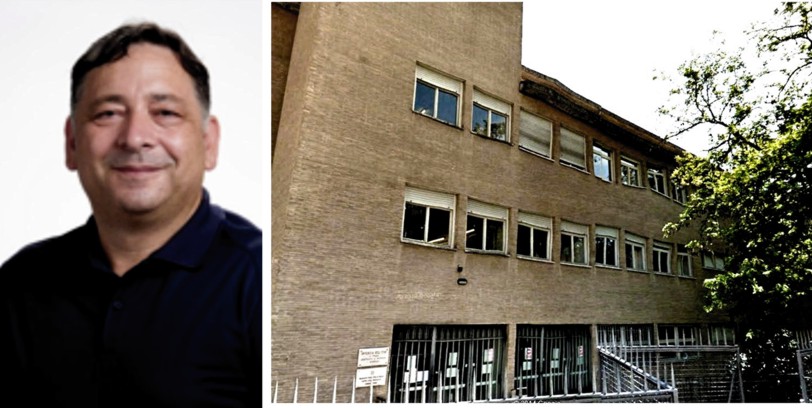
Wednesday, October 29, 2014
Analysis #3 Of Testimony Of Dr Chiacchiera, Organized Crime Section: Contradictions Between RS & AK
Posted by Cardiol MD
1. Overview Of This Series
In 2007 Dr Chiacchiera was the Director of the Organized Crime Section and the Deputy Director of the Flying Squad.
He was one of the most senior and experienced law enforcement officers to testify at the trial. His testimony and his cross examination by the defenses occupied a lot of time of the court late in February 2009. He covered the following ground.
(1) He found Knox and Sollecito uncooperative when he asked them questions.
(2) Saw evidence contradicting any lone burglar theory and indicating that the “break-In” to Romanelli’s room was faked.
(3) Phone records and the police investigation into the accused phone activity the night of the murder.
(4) Discovery of pornographic magazines at Sollecito’s house.
(5) Details of how the large knife, Exhibit 36, was collected from Sollecito’s and the evidence that it is the murder knife.
Dr Chiacchiera was submitted to cross-examination on the above 5 items by 4 Attorneys for the Defence of Knox and Sollecito, by 2 Civil Party Attorneys, and to Re-examination by the Prosecution. He had a gruelling time as a witness.
All the translation is by the ever-dedicated main poster ZiaK. This series is highlighting some key portions. Here is the full 50-page transcript which will be posted in the trial testimony area of McCall’s great Wiki.
(GCM=Giancarlo Massei; MC=Manuela Comodi; MaCh=Marco Chiacchiera; GB=Giulia Bongiorno; DD=Donatella Donati; CP=Carlo Pacelli; LG=Luciano Ghirga; CDV=Carlo Dalla Vedova; FM=Francesco Maresca)
Continuation of Dr Chiacchiera’s Evidence-in-Chief:
MaCh: It emerged that normally Sollecito kept his cellphones, and also Amanda Knox, they kept their cellphones on until a late hour, evening, [sic] there is no telephone traffic from 20:40 hours. A thing of this “¦
{Witness begins Testimony re cellphones and is interrupted}
MC: But did this emerge from the declarations or did it emerge from the analysis of the [phone] records in the preceding days?
{Examiner interrupts witness with good Q re source of telephone-usage information}
MaCh: It emerged from the analysis of the [phone] records in the preceding days.
{Witness answers clearly}
GCM: Excuse me. Let me understand. In other words you say: the cellphone was switched off and there was no telephone traffic, these are two different things.
{Court asks good clarifying Q}
MaCh: I’m saying, Mr President. Two things. The first, normally Sollecito’s telephone and the telephone of Amanda, were switched on until the late hours. The fatal evening, they were switched off from 20:42 hours until “¦ one [of the phones] from 20:42 onwards and the other from about 20:50 onwards. One. Two, the traffic “¦
{Witness is Answering Court's Q in 2 parts. When he gets to his part #2, Court interrupts}
GCM: Before going on to “Two”, excuse me: “normally” ““ what does that mean? You had “¦
{Court is asking good Q re witness's Part #1, but is interrupted}
MaCh: We had done a comparative analysis of the telephone traffic of that evening with the telephone traffic of the preceding evenings. Shall we say the habits ...
{Witness interrupts Court with narrative response, and is also interrupted}
GCM: And so the “normally” emerges from this?
{Court interrupts witness's response with good Q}
MC: How many evenings? If you recall, or not?
{Examiner asks witness relevant Q, adding redundant Q}
MaCh: Months, no “¦ honestly, I don’t remember how many [evenings], but months.
{Witness stumbles, seeming uncertain re 'evenings' vs 'months'}
MC: I mean to say, not “¦
{Examiner preambles re her redundant Q but is interrupted}
MaCh: Not three days, no. The telephone traffic habits were evaluated. [This is point] one. [Point] Two, the element that emerged, that contradicted the declarations, I can’t report on the declarations but I can report on the element that contradicted [sic. i.e. provided the contradiction], that in effect no telephone call had arrived at 23:00 hours, as had been declared: on the phone line that was declared to have received that “¦ the recipient of that very phone-call. Another element: no interaction with the computer emerged, unlike what was declared. So there were a few objective elements of comparison from the analysis and from the technical checks that contradicted what had previously been revealed.
{Witness interrupts Examiner with narrative response to Examiner's Q, witness indicating contradiction between suspects' declarations and objective records of telephone and computer activity}
MC: For Amanda Knox, were there incongruities of this type?
{Examiner asks if incongruities/contradictions existed for Amanda Knox}
MaCh: Yes, there were incongruities because Amanda Knox was, how to say, contradicted by Sollectio, and then she contradicted herself, if I may “¦
{Witness answers affirmatively, amplifying applicability both to Sollecito & Knox, but is interrupted}
GB: President, if we continue in this way, then we might as well do the old [trial] procedure.
{Giulia Bongiorno, Sollecito's lawyer interjects, objecting-subjectively to Court, but submitting no legal basis for her objection}
GCM: Excuse me, please.
{Court seems to politely rule GB out-of-order}
MaCh: The elements, these are [sic], Mr President, I don’t know how to do.
{Witness communicates uncertainty to Court}
MC: But it is so difficult, however.
{Examiner chimes-in apparently commiserating with her witness's uncertainty}
MaCh: Mr President, I really don’t know what to do.
{Witness seems to repeat statement addressed to Court, who possibly interrupts}}
GCM: Excuse me”¦
{Court seems to begin response to Witness, but is possibly interrupted}
MaCh: If I have to describe the investigation activity “¦
{Witness may be interrupting Court or is continuing Witness's unfinished statement to Court}
MC: He’s not referring to declarations.
{Examiner chimes-in with his opinion re Witness's reference to Defendants' contradictions/incongruities - GB's interjection seems to have side-tracked court procedure}
GCM: Regarding these declarations, you can report on this [sic. i.e. in this instance?], and with regard to Raffaele Sollecito, you reported ““ citing the telephone traffic and citing the use of the computer. There now, and this is one point. With regard to Amanda Knox, you cannot report the declarations. But you may, however, say ““ following these declarations ““ what type of investigations you carried out, and the outcome of these. So, following the declarations given by Amanda Knox, did you do similar investigations, as [those you did] for Sollecito Raffaele on the [phone] records? Or was there nothing to do, except to “¦?
{Court rules on subject of testimony re Defendants' declarations, seeming to rule admissibility of Sollecito's declarations re telephone traffic and computer usage, but inadmissibility of Knox's declarations. Court does seem to permit description of investigations that followed Knox's declarations, without describing Knox's actual declarations, and Court asks whether phone-record investigations similar to those done for Sollecito were done for Knox.}
MaCh: Mr President, all the necessary checks were made, but in that immediate moment the most important element “¦ that is to say, in [this] place [NdT: i.e. “in this Court”], in this moment, in this place, that is to say, when they were “¦ I said [that] when the arrests were made, I don’t, I don’t know how to do, however, the incongruity of the declarations with the facts that we had found, and with the declarations that Sollecito had previously given us, [this] was the most important element. I don’t know if I have managed to “¦
{Witness seemingly responding to Court that he doesn't know how to deal with the declarations, is interrupted.}
GCM: No, excuse me (overlapping voices). So, with regard to Raffaele Sollecito, we have
understood these checking activities were carried out on the declarations made, the verification activities carried out, and [that’s all] very well. With regard to Amanda Knox, if you also carried out “¦ maybe there were no objective elements for possible checking, there were no “¦ or else, there were activities carried out of “¦
{Court, interrupting over witness's testimony, seems to be explaining his Q to witness, but is interrupted by witness}
MaCh: Later, there emerged a series of further elements.
{Witness interrupts with statement re unspecified further elements}
GCM: Not evaluations on the congruity, incongruity, likelihood, these are evaluations and will be done, there you go, comparably. I’m thinking of the [phone] records, of the use, if she had given indications on the basis of which [you] could carry out investigative activity “¦
{Court seems to want evidence in Knox's phone records justifying further investigation.}
Here ends the Testimony Of Dr Chiacchiera covering the relevant Phone Records, elicited by the Prosecution.
Next comes the Testimony Of Dr Chiacchiera elicited by the Prosecution, covering Discovery of pornographic magazines at Sollecito’s house, Details of how the large knife, Exhibit 36, was collected from Sollecito’s and the evidence that it is the murder knife
Thursday, October 16, 2014
Knox, Tied In Knots By Her Own Tongue: Translation Of The 17 Dec 2007 Interview With Dr Mignini #4
Posted by Machiavelli, Catnip, Kristeva
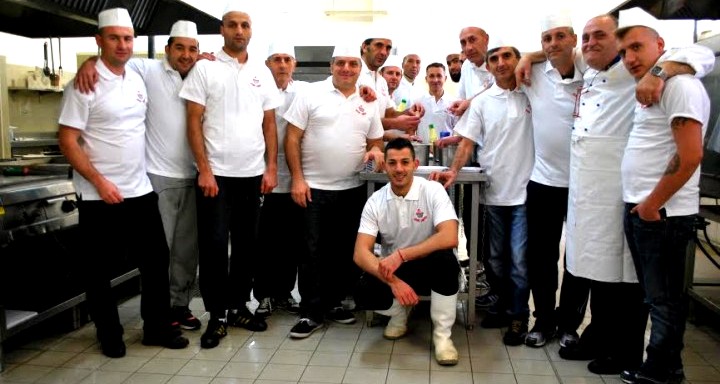
Inmate-chefs at Capanne Prison, from which Knox was making a bid for release
1. Getting Up To Speed On This Fourth Post
How much serious questioning was Knox subjected to prior to this voluntary interview six weeks after her arrest?
In fact, none. In the early days of November, after Meredith was found dead, she had several less-formal “recap/summary” sessions with investigators on possible leads (as did many others), which the defenses conceded without argument at trial were simply that and no more.
So these were the first serious questions put to Knox - politely, and Knox is essentially not argumentative throughout
The transcript was in the evidence pile and all judges except Hellmann seem to have studied it hard. This was also the first-ever interview of Knox by Dr Mignini, as prosecutor appointed to the case. He had seen her twice at the house and heard her at her strong insistence early on 6 November.
But they had never before really talked.
Prior to this, Knox had already emanated over a dozen differing versions of what she wanted to claim took place and the police and prosecutors and Supervising Magistrate Claudia Matteini had tried to make sense of those.
2. Our Translation Of Approximately The Fourth 40 Minutes
This is the fourth 40 minutes of the voluntary interview which lasted in total about three hours. For a full understanding it would really be best to read (1) our first post and comment thread and (2) our second post and comment thread. and (3) third post and comment thread.
Transcript of Interview 17 December 2007: Statement of Interview Of Ms Amanda Knox (cont)
PM Mignini: After having talked, after you were heard at the Questura, did you go away or did you wait?
Knox: The first day I was questioned I was there for hours”¦ maybe 14”¦
Interpreter: The first time it seems to her that she had been there a very long time, 14 hours
PM Mignini: But questioned
Knox: No, maybe they questioned me for 6 hours but I stayed at the Questura a very long time”¦
Interpreter: It must have been more or less 6 hours that Amanda was questioned but staying in the Questura must have been about”¦
PM Mignini: But was there”¦ were you in the waiting room?
Knox: Yes the whole time together with everyone else we were there in the waiting room”¦
Interpreter Yes, yes together with the other ones
PM Mignini: And who were the other people?
[82]
Knox: The housemates, and later others arrived”¦ After quite a long time our neighbors arrived, after a while some people Meredith knew arrived, her friends
Interpreter: Her housemates and then other people who arrived later, the neighbors after a while”¦ and after, Meredith’s friends arrived, the people Meredith knew”¦
PM Mignini: But did you speak to them? Did you exchange any confidences?
Knox: Yes we were all there and I said “it appears that Meredith’s body was found in a closet”
PM Mignini: Who said that?
Knox: I remember talking to her friends and I remember telling them that it appeared the body had been found inside a closet”¦
Interpreter: She remembers having said it to Meredith’s friends
PM Mignini: But friends, who? You must tell us the name”¦ a name even just the name”¦
Knox: I remember having talked to Sophie”¦ But I don’t know the name of the other friends
PM Mignini: A certain Natalie? From London
Knox: The name sounds familiar but I don’t think I could recognize her face
Interpreter: She can’t tie the name to her face but”¦
PM Mignini: And what were you saying? What kind of comments were you making?
[83]
Knox: I told them what I knew, I told them that I had arrived home and found the door open, and told them what I knew”¦
Interpreter: She told what she knew that she had arrived home and found the door open
PM Mignini: Did you ever see, did you see in those moments the wound on Meredith’s neck?
Interpreter: Up to the moment?
PM Mignini: In that moment.
Knox: I never saw Meredith dead, I never saw her dead body”¦
Interpreter: No, she never saw her dead
PM Mignini: Ok, but was there anyone that night who said, anyone who said that she had died quickly? Did someone else say that she must have suffered for a long time”¦ was there anyone who said this?
Knox: Nobody of the people I talked to knew what had happened”¦
Interpreter: No, none of the people she talked to said something”¦ knew what had happened
PM Mignini: Did you come to know, did you ever come to know, and if yes, when, in what moment, Meredith had died”¦ that is, if Meredith’s death was immediate or if it was prolonged, if there was a death agony”¦ if yes, when did you find that out?
Knox: The only time when I heard of this was when Luciano [Ghirga] was describing the wound and how deep it was”¦ What kind of wound it was and he said “maybe she died slowly because no big vein had been struck”
Interpreter: So, the first time you had heard talking about the wound and how she died”¦ when was it with Luciano?
Lawyer: The morning of the 8th
[84]
PM Mignini: So, after the 6th…
Lawyer: The morning of the 8th
PM Mignini: The morning of November 8th
Lawyer: After the arrest validation [hearing]
Interpreter: And there she found out that no vital vein was directly struck and therefore”¦
PM Mignini: You say that she came to know on the 8th from the lawyer.
Lawyer: From the lawyers.
PM Mignini: From the lawyers, sorry.
Lawyer: We always came all together
PM Mignini: Either one or the other [of you] could have told her”¦ so”¦ [talking to Knox] I formally notify [for the record, a contradiction] that an Erasmus student and a colleague of this student, they said, on this past December 10th that on the night of the second in the Questura, while having”¦ a girl called Natalie, I won’t tell you her last name but she”¦ she was a friend of Meredith, she had noticed that you were talking at length with Sollecito, and at a certain point, in response to a comment made by one of these girls that they hoped Meredith had died without suffering, you instead said ” with those kind of wounds the death would not have come fast and that therefore Meredith must have died after a certain period of time”. I’ll reread it to you if you’d like, ok?
Knox: The police told me that her throat was cut, and what I know about that topic, I mean when they cut your throat, it is terrible and I heard that it’s a horrible way to die”¦
Interpreter: Yes the police had told her that Meredith’s throat was cut and what Amanda knew is that it’s an agonizing way to die”¦
[85]
PM Mignini: But this is something we found out after, we too found it out only later”¦ not right away”¦
Knox: The police told me that her throat had been cut.
Interpreter: The police had told her that her throat had been cut.
PM Mignini: Who from the police? Excuse me I’d like to know”¦ cutting the neck, it can happen in many ways, vital veins can be struck and might also not be struck, therefore one thing is about cutting the throat, and another is about the way how to cut it and therefore make it so that the death occurs instantaneously, or cause a death with agony. On the evening of the second, if it’s true, according to these results, on the evening of the second you knew that, with those kind of wounds, she must have suffered an agony”¦ and the police didn’t know that”¦
Knox: I thought that a death by cutting the throat was always slow and terrible”¦
PM Mignini: The autopsy was made on the fourth, two days later
Interpreter: What she thought was that cutting the throat was always a slow death in general
PM Mignini: It’s not like that”¦not necessarily”¦ anyway, who from the police told you about the neck wound? Tell us.
Knox: It was probably the interpreter”¦the first interpreter was the person I talked to the most”¦ all information I had came more or less from him”¦
Interpreter: Probably the translator/interpreter
PM Mignini: Therefore, therefore he told you while you were being heard”¦
Lawyer: She was in there 12 hours
[86]
Knox: When I was in there I was talking to the police and they told me that her throat was cut”¦ the whole conversation was between me and the interpreter. It was him who must have told me, a long time has passed but I think it was like that”¦
Interpreter: Directly from the interpreter, indirectly from the police
PM Mignini: So [it was] when you were questioned. Not before.
Interpreter: No, before she was questioned she didn’t know how she was”¦
Knox: No, when I was home the way she died”¦
PM Mignini: Before being questioned”¦ you were questioned until 15:30, until what time have you been heard? You were being heard since 15:30, until what time were you being heard?
Knox: I don’t know it was a long questioning”¦
Lawyer: She had been heard in the presence of an interpreter, maybe the interpreter”¦
PM Mignini: It was D’Astolto”¦ Fabio D’Astolto
Lawyer: The interpreter was present from the beginning or only from the questioning onwards?
PM Mignini: Yes, well he was a policeman acting as an interpreter, translating. Fabio D’Astolto. Assistant D’Astolto. When and how, in what terms did D’Astolto express himself, this translator what did he tell you?
Lawyer: When?
PM Mignini: When and what did he tell you
Knox: I don’t remember when but I asked him how she died
Interpreter: She doesn’t remember when but she asked him how she was killed”¦
PM Mignini: And he pointed out to you the wound on the neck. The wound on the neck and that’s all. Fine. This translator.
[87]
Lawyer: [to the Prosecutor] You referred to an Erasmus student who had said that on December 10th. Ms. Natalie would have said this.
PM Mignini: Yes
Lawyer: And is the Erasmus student indicated [in the records]?
PM Mignini: It is indicated
Lawyer: Do we have a name?
PM Mignini: Capruzzi, Filippo and the other one is a certain, a colleague of his, Chiara, Maioli.
Lawyer: So it was two Erasmus students
PM Mignini: Two Erasmus students who confirmed this confidentiality from this English girl. Some”¦ this is the December 10th hearing report”¦ ok
Lawyer G. She clarified if she had talked with the interpreter, with someone before”¦
Lawyer C. We have clarified that the interpreter was not an interpreter but was a police officer who speaks English and that apparently was present from the beginning and therefore at this point…
PM Mignini: Wait.. one moment”¦ did you, did you”¦ did you see this person who was translating at the house?
Knox: No
Interpreter: No
PM Mignini: Perfect
Lawyer: She was approximately 12 hours in the Questura and at some time she heard the first… let’s call it questioning but it was a long time, and before the questioning she heard of this wound on the neck, is that right?
[88]
PM Mignini: During the questioning, you said before, during the questioning so much as this policeman translator was present, therefore”¦ no I’m very sorry, who did you hear this from? The translator? The policeman
Interpreter: About the wound? The first time?
PM Mignini: The wound
Knox: I think so
Knox: The first time?
PM Mignini: Yeah
Interpreter: I think the interpreter the first time
PM Mignini: And it would be this D’Astolto”¦ so this D’Astolto told you, please excuse me you told me this “it was D’Astolto” now”¦ therefore this D’Astolto told you this during the course of the questioning?
Knox: I think so”¦
Interpreter: Yes, she thinks so
PM Mignini: Ok, one more thing, so the”¦ you did, the morning of the”¦ actually no, the night between the fifth and the sixth of November, you did, let’s say partially modify your previous declarations, so then you modified your previous declarations and you made a specific accusation against Patrick Dia Lumumba known as Patrick. You said that you were supposed to meet with Patrick, that you met with Patrick at the basketball court of Piazza Grimana, that you went to Meredith’s house, to your house, and then he had sex with Meredith, then you heard a scream and you accused him even if in terms you say “confusedly” of killing Meredith. Isn’t that so? Why did you make this accusation? “¦ Now remember, I was hearing you, I was present, you were crying, you were
[89]
profoundly upset, and you were as if relieved when you made this statement.
Lawyer: Maybe she was stressed?
PM Mignini: Well, stressed or not, in any case she was very she made these declarations
Lawyer: You asked her a question “Why did you make these declarations”?
PM Mignini: Well I also have to”¦
Lawyer: Eh these are opinions
PM Mignini: I am saying that you made a declaration not in a detached way, in other words in a very involved manner, why did you make these statements?
Knox: I was scared, I was confused, it had been hours that the police that I thought were protecting me, and instead they were putting me under pressure and were threatening me.
Interpreter: She was scared, she was confused, it had been hours that the police were threatening and pressuring her.
PM Mignini: Yes, tell me, go on
Knox: The reason why I thought of Patrick was because the police were yelling at me about Patrick”¦ they kept saying about this message, that I had sent a message to Patrick”¦
Interpreter: The reason why she thought of Patrick was because the police was asking her who was this Patrick to whom she sent, with whom there was this exchange of messages, they were asking her insistently.
Knox: That was the worse experience of my life
Interpreter: The worse experience of her life
[90]
Knox: I had never been more confused than then
Interpreter: She had been so confused or scared
PM Mignini: But in the following memoriale [spontaneous statement around noon 6 November] that you wrote before going to prison, basically you don’t retract this accusation. Even if in terms, still in terms let’s say of uncertainty, between dream and reality, in other words in such a way “¦ still you didn’t “¦ I believe that in this memoriale you say “I still see this image in front of me” and then you see yourself while hearing it, you say that in that first memoriale you wrote “you hear Meredith’s screams and you put your hands over your ears”. Why do you have this image? Your ears”¦ the scream”¦ it’s not like it’s changing much after all isn’t that so?
Lawyer: No, but she says she was very confused”¦ she was under a lot of stress
PM Mignini: Yes, but why does it basically remain the same, this one”¦
Knox: Yes, I imagined these things”¦
Interpreter: Imagined this scene
Knox: I was so scared and confused
Interpreter: I was so scared and confused
Knox: that I tried to imagine what could have happened. The police told me that I was probably not remembering well. So I thought of what could be another answer and therefore I imagined it”¦
Interpreter: She tried to think of what could have happened since the police was saying that probably she didn’t remember well. And therefore she imagined this scene, trying to think how it could have happened
PM Mignini: Well, you, I just tell you, I tell you only that this Dia Lumumba, this Patrick, only comes up in your statements, he wasn’t, he has never been indicated previously in the slightest, I mean why did you, why did you almost feel…
[91]
...forced to, so you say, to give this name? While this name had never been, you had never mentioned him previously”¦ in the statements of the 2nd, the 3rd”¦. Why only at a certain point di this Patrick pop up? I’m telling you, do you realize”¦ excuse me, eh? “¦ excuse me”¦.
Knox: They were telling me “why did you send this message to Patrick, this message to Patrick!”
Interpreter: Because they were always insisting about this message to Patrick and because”¦
PM Mignini: Well because there’s the message so [it’s] the message but it’s just that, it’s not that there was an attitude, I mean it’s not like there was any reference to a message according to what emerges from the statements. In fact there was a message that you”¦ since there had been an exchange of messages right before the time of the murder between you and this person it’s normal that the police would want to know why, what this message meant, this”¦ therefore it’s not something”¦ why did you threw yourself in this kind of”¦ ? While you had, you had the possibility to”¦?
Knox: Because I thought that it could have been true
Interpreter: Because she thought it could have been true”¦
PM Mignini: It could have been true?
Lawyer: Why?
Knox: When I was there, I was confused”¦
PM Mignini: [to the lawyers, ed.] No, no, excuse me, at this point no, I’m sorry. Not the lawyers. The defense can intervene against me but against the person investigated…?
Lawyer Ghirga: But there was no question”¦ Prosecutor there was no question
PM Mignini: It could be true. What does it mean?
[92]
Lawyer Ghirga: There was no question
PM Mignini: What? I am asking the question.
Lawyer Ghirga: Then ask it.
PM Mignini: What does it mean, how “˜could it be true’? What?
Lawyer Ghirga: What could be true?
PM Mignini: Excuse me, lawyer
Lawyer Ghirga: It’s like the phone call with her parents
PM Mignini: What could be true
Lawyer Ghirga: It’s like the phone call with her parents
PM Mignini: “¦Lawyer Ghirga”¦ what”¦?
Lawyer Ghirga: [seems to Knox] What do you want to say then? Let’s ask her”¦
PM Mignini: Excuse me, I am asking the questions, I am asking them now
Lawyer Ghirga Yes of course
PM Mignini: Then after you can”¦ I am asking her”¦
Lawyer Ghirga: Yes of course, we will ask them too”¦
PM Mignini: Lawyer”¦ she is saying “it could have been true””¦
Lawyer: What?
PM Mignini: “it could have been true”. She was telling me why did she accuse Lumumba of this fact? “It could have been true” is what she answered. Gentlemen, here”¦
Knox: I said it because I imagined it and I thought that it could have been true”¦
Interpreter: She said because she had imagined it and therefore she thought it could have been true.
[93]
PM Mignini: Look, listen”¦ listen, why did you imagine it?
Knox Why?... Because I was stressed
PM Mignini: Why didn’t you imagine”¦
Lawyer: No she was answering
PM Mignini: Yes; what did you want to say?
Interpreter: Because she was under stress”¦
Knox: Knox: Why? I was stressed, I was scared, it was after long hours in the middle of the night, I was innocent and they were telling me that I was guilty
Interpreter: Because they were saying that she was guilty
PM Mignini: Who was saying it? Guilty who’”¦.
Interpreter: After hours”¦
Lawyer: Excuse me, prosecutor, if we can correctly compile this translation, these words that were said in English at the right moment
PM Mignini: She is crying, we acknowledge, I’m sorry, we acknowledge that the”¦ investigated is crying.
Interpreter: Because she was stressed, scared under pressure after many hours, she was”¦ in the middle of the night, they had reached the middle of the night and because they were saying that Amanda was guilty.
PM Mignini: Who was saying that she was guilty?
Interpreter: The police
Lawyer: The police was accusing her
Interpreter: The police was accusing Amanda
[94]
PM Mignini: Why”¦ why did you accuse Lumumba and not others? How many people did you know who could”¦
Knox: Because they were yelling Patrick’s name”¦
Interpreter: She accused Patrick and not others because they were always talking about Patrick, suggesting”¦
PM Mignini: The police, the police couldn’t suggest…
Interpreter: Yelling Patrick’s name
PM Mignini: Excuse me, what was the police saying?
Interpreter: What did the police tell you?
Knox: The police were telling me that “˜we know that you were at the house, we know that you left the house’, and the moment before I said Patrick’s name they put.. someone was showing me the message that I had sent on the phone
Interpreter: The police said that they knew that Amanda was inside the house, and when she went in, when she went out, that she was inside the house, and while they were asking her this someone showed her Patrick’s message on the phone.
PM Mignini: But this is”¦ But this is normal. You”¦ there was this message”¦ I’m sorry, I’m very sorry. There’s a murder here. There’s a girl whose throat is slit, there was a phone number, there was a call that had been made, you were being heard. There was a call that had been made to you on the night of the murder from this person, you replied to this call in a way that could have been interpreted, according to the meaning in Italian “will see you”. Eh, so what is more normal than to insist? The police are doing their job. They insist to know, what did that mean, what was the, what relationship was there between you and Lumumba. This is normal.
[95]
Knox: I didn’t understand why they were insisting that I was lying”¦ they kept telling me that I was lying”¦
Interpreter: She didn’t understand why they were insisting that she was lying.
PM Mignini: Why are you”¦?
Interpreter: The police was insisting that she was lying.
PM Mignini: But why did you accuse, then if it was like this…. Again you are, you are crying again, for a long while since you started, I put in the record, I put in the record that”¦ it’s been ten minutes that you have been crying. Why did you accuse a person that, today, you’re telling us he is innocent, but earlier you just told us “it could be true” what does “it could be true” mean? You have told me “it could be true”.
Lawyer: The subject is missing
PM Mignini: No the subject is there, because I asked the question. Why did you accuse Lumumba?
Lawyer: Can we suspend a moment please?
PM Mignini: What reason?
Knox: It means that in the moment when I told Patrick’s name, I thought that it could have been true.
Interpreter: In the moment in which she said Patrick’s name, in that moment, she thought it could have been true.
Lawyer Ghirga: We ask for a suspension”¦ she is calm, you say she is crying, and we think she’s not.
PM Mignini: I put that in the record it because I could see the tears, she was crying and I could hear her too.
[96]
Lawyer: It was not ten minutes long
PM Mignini: Well, even more, maybe
Lawyer: maybe, no less
PM Mignini: Let’s interrupt, break off.
Lawyer: You asked her six times”¦
PM Mignini: For Heaven’s sake, let’s interrupt, break off.
(interruption)
[from this point on Amanda declares her right to remain silent]
PM Mignini: So, at 15:12 lawyer Luciano Ghirga resumes the interrogation
Lawyer Ghirga: In the name of the defensive collegium we submit a reason to confer personally, privately, we mean alone together with our client, for a time not longer than ten minutes.
PM Mignini: So, the Public Prosecutor is pointing out that the interrogation had already been suspended and it’s 15: 13 now, pointing out that the interrogation was suspended several times, and the last time for, how long? Ten minutes on request of the defence, and the defence will be allowed to fully have counsel with the person under investigation at the end of the interrogation. [The Public Prosecutor] orders to proceed, orders to go forward with the investigation procedure. So now I would like”¦
Lawyer Ghirga: If you may, ask to the suspect, to the person under investigation, whether she intends to go on or to invoke her right not to answer”¦?
PM Mignini: This is a”¦ it’s a”¦ it’s a”¦ she decided to answer questions at the beginning. Now if she decides to make a statement where she says “I don’t want to answer any more” she’ll be the one who says it, and it’s not that I must ask now, that question was done at the beginning of the interrogation. If now she wants to say”¦
Knox: I prefer not to answer any more”¦
[97]
Lawyer Ghirga: What did she say?
Interpreter: She doesn’t want to answer anymore.
PM Mignini: So, at this point, at 15: 15, on a question asked by the defence lawyers, about whether the person under investigation intends to go on answering or not”¦
Lawyer Ghirga: To your questions
PM Mignini: To a question by lawyer Ghirga”¦ yes, well, Lawyer Ghirga asked her that
Lawyer: He didn’t first ask the question
Lawyer Ghirga: But what question did I ask?
Lawyer: We told you to ask her…
PM Mignini: Yes, you asked me, and I did follow the request. But”¦
Lawyer Ghirga: She made a declaration, and we took note, unfortunately, about forbidden suggestions”¦ but on what request”¦?
PM Mignini: Now at this point, at 15: 15 the defence lawyers… Let’s put like this, the defence lawyers ask this Prosecutor about whether he intends to ask the person under investigation if she intends to go on answering questions, but then, after my decision, Lawyer Ghirga said”¦
Lawyer Ghirga: Who said? You said
PM Mignini: You asked her, I put in the record what happened, it’s recorded anyway, this is what I perceived you asked her, and she answered “I do not intend to answer”, she said, and then the interpreter…
Lawyer Ghirga: I asked whether she intended to make a statement, and she made a statement
PM Mignini: You indicated that to her, it changes nothing, doesn’t change”¦ I must only put in the record what happened. The public prosecutor points out that…
[98]
...the warning about the right not to answer was explained to the person under investigation at the beginning of the interrogation, as provided by the Code, and that same [person under investigation] declared she wanted to answer. It is not possible now to invoke the duty to inform the suspect about her right, because such requirement has been already fulfilled. Anyway the person under investigation can, if she decides to, declare that she doesn’t want to answer any more. Such option has been shown to the person under investigation by lawyer Ghirga.
Lawyer: ...by the defence lawyers
PM Mignini: By the defence lawyers, to the person under investigation. What do you want to do?
Lawyer: What do you mean by “It was shown?”
PM Mignini: It was shown, because you said”¦ I need to put in the record what happened. The lawyer… Facing my warrant which I described, the notice was provided at the beginning of the interrogation as the code requires. She said “I want to answer, I do not intend to invoke my right not to answer”. That answer had been given already, I informed her, and she answered. Now to this, at this point, however, I said nothing prevents her from wanting, from declaring “at this point I do not intend to answer any more”. I put it in the record and I don’t ask why, at that point, at that point.
Lawyer: You should not put in the record “the defence lawyers have shown”¦”
PM Mignini: “at that point”
Lawyer: We did not show anything, we asked to be allowed to, well”¦ and you said no.
PM Mignini: So”¦ lawyer, lawyer?
Lawyer: And you said no, and we didn’t have the possibility to show her…
[99]
PM Mignini: Lawyer Ghirga”¦ Lawyer Ghirga”¦
Lawyer: that she might invoke her right to not answer. It’s not that it’s we who’ve shown this possibility this is what I want to explain”¦
PM Mignini: Lawyer Ghirga told her something, so…?
Lawyer Ghirga: No, no, I only said, if you could give us a ten minutes suspension
PM Mignini: You told her something, now come on”¦ I need to put that on record
Lawyer Ghirga: what did I say”¦
PM Mignini: You have shown, I don’t know if the other lawyer did too, you told, Lawyer Ghirga, you told the person under investigation about… You said, if you can, if I remember correctly, we’ll hear her again”¦
Lawyer Costa: It was me who told her, Mr. Prosecutor
PM Mignini: So I understood Lawyer Ghirga… Lawyer Giancarlo Costa declares he explained that, I didn’t say anything else
Lawyer Costa: ... To Ms. Amanda Knox to use her right to invoke her right not to answer
PM Mignini: ... And she herself declares so, she is supposed to declare what she wants
Lawyer: She has already said that
PM Mignini: Let’s repeat it since with this superimposition of voices”¦ the interpreter will translate faithfully word-by-word what you say.
Knox: At this point I don’t want to answer any more
Interpreter: At this point she doesn’t want to answer any more
PM Mignini: So “at this point I don’t want to answer any more”. We put on record that the current transcript was recorded entirely.
[100]
Lawyer Costa: Mr Public Prosecutor, we lawyers may renounce to our own time terms of deposit if Your Honour would give us a copy
PM Mignini: Yes, no problem”¦ at 15: 22. The parties demand a transcription, I mean the defence lawyers request the transcription of the recording.
Sunday, October 05, 2014
Knox Interrogation Hoax #14: Third Opportunity Knox Flunked: Requested Interrogation By Dr Mignini
Posted by Machiavelli, Catnip, Kristeva
1. Our Translation Of Knox’s Key Interview
At her request Dr Mignini interrogated Amanda Knox, her first true interrogation under Italian law, on 17 Dec 2007.
This was about six weeks after her arrest. If Knox had explained away the charges against her, she could have been on her way home.
Read our translations for how it finally emerged. There is some context in Part 2 below.
Knox, Tied In Knots By Her Own Tongue: Translation Of The 17 Dec 2007 Interview With Dr Mignini #1
Knox, Tied In Knots By Her Own Tongue: Translation Of The 17 Dec 2007 Interview With Dr Mignini #2
Knox, Tied In Knots By Her Own Tongue: Translation Of The 17 Dec 2007 Interview With Dr Mignini #3
Knox, Tied In Knots By Her Own Tongue: Translation Of The 17 Dec 2007 Interview With Dr Mignini #4
Part 2: Context Of The Interview
Dozens of people have very aggressively gone to bat for Knox over her “interrogation” and still do. They trust that one or other of her versions of the 5-6 November 2007 police-station session finally stands up.
This interview was sought-after by Knox, seeing this as her last best chance to get herself off the hook before trial and to avoid remaining locked up. This lasted about three hours, until Knox’s lawyers interrupted to got her to clam up.
All of the trial judges and appeal judges and lay judges had clearly studied this document hard. Also prosecutors and the Knox and Sollecito defense counsel periodically refer to it.
As you will have seen in previous posts, Knox’s team pussyfooted about without conviction in the few brief instances when the 5-6 November session was discussed.
In this Mignini hearing of 17 December 2007 they eventually in effect advised her it would be in her best interests to shut up.
Thursday, September 25, 2014
Analysis #2 Of Testimony Of Dr Chiacchiera, Organized Crime Section: Discounting Any Lone Wolf
Posted by Cardiol MD
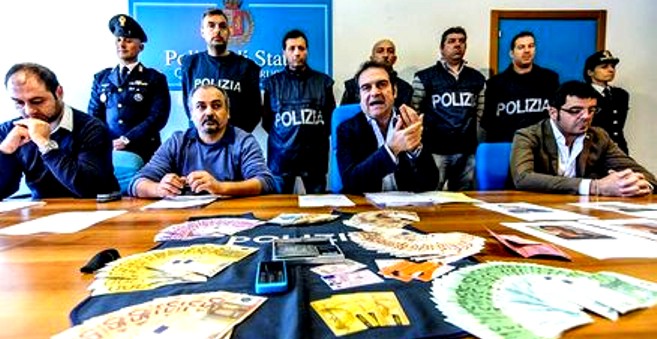
Dr Chiacchiera (talking) with his team explaining reason for charges in another case
Overview Of This Series
In 2007 Dr Chiacchiera was the Director of the Organized Crime Section and the Deputy Director of the Flying Squad.
He was one of the most senior and experienced law enforcement officers to testify at the trial. His testimony and his cross examination by the defenses occupied a lot of time of the court late in February 2009. He covered the following ground.
- (1) He found Knox and Sollecito uncooperative when he asked them questions.
(2) Saw evidence contradicting any lone burglar theory and indicating that the “break-In” to Romanelli’s room was faked.
(3) Phone records and the police investigation into the accused phone activity the night of the murder.
(4) Discovery of pornographic magazines at Sollecito’s house.
(5) Details of how the large knife, Exhibit 36, was collected from Sollecito’s and the evidence that it is the murder knife.
All the translation is by the ever-dedicated main poster ZiaK. This series is highlighting some key portions. Here is the full 50-page transcript which will be posted in the trial testimony area of McCall’s great Wiki.
This post continues analysis of the evidence that the lone burglar/lone wolf theory was not credible to those that were first on the crime scene and that the “break-In” to Filomena Romanelli’s room was to them obviously faked.
(GCM=Giancarlo Massei; MC=Manuela Comodi; MaCh=Marco Chiacchiera; GB=Giulia Bongiorno; DD=Donatella Donati; CP=Carlo Pacelli; LG=Luciano Ghirga; CDV=Carlo Dalla Vedova; FM=Francesco Maresca)
Public Prosecutor Comodi [MC] Leads Testimony
Judge Massei [GCM}: Excuse me a moment, just to give some guidelines, but of the evaluations that the witness is expressing, obviously it’s not that they can be taken account of, however we will acquire them [for the trial files] in order to understand the investigation activities, the appropriateness of the investigations that were carried out, directed in one way or in another, there you go. However, maybe, “¦ there you go, yes, maybe if we can manage to keep with the bare essentials this will help everybody.
{Court proceedings seem to have been diverted into a free-for-all colloquy, with multiple participants chiming-in, and creating confusion. Court-President, GCM, now politely intervenes, apparently trying to restore order, ruling that the professional evaluations made by the witness, testified-to by the witness, should be admitted for the trial files. The appropriateness of the witness's evaluations can be dealt with separately and later.}
Manuela Comodi [MC}: Well, in short, they were called “¦ they are the only ones who can describe the whole progression of the investigations - Dr Profazio and Dr Chiacciera ““ because they are directors, they are the only ones who will come to describe for me, thus, what was the progression of the investigations. Clearly, in order to pass from one investigative act to another rather than “¦ and the choice of the subsequent investigative acts. It’s clear that they have to describe, in order to make a complete reasoning, even the lines of thought that, as Dr Chiacchiera said, it sometimes happens that they make. However, one point: apart from the break-in, apart from the broken window, there are “¦ did you acquire further elements that corroborated the idea that there had been a burglary? Nothing from Romanelli’s room had been carried off? Valuable things had been taken?
{Examiner acknowledges Court's admonition, argues importance of her witness's testimony, and segués into triple-Q addressed to witness re elements corroborating idea of burglary.}
Dr Chiacchiera [MaCh]: This ... in fact, in the progress ...
{Witness begins to answer, but is interrupted by Examiner}
MC: Was a declaration/complaint of theft made then, with a list of the things taken?
{Examiner interrupts witness with new double-Q}
MaCh: In the logical progression, if I may in some way still, in summary, say what “¦.
{Witness begins narrative response but is interrupted by Court}
GCM: Say the objective facts, if you have “¦.
{Court interrupts witness, beginning to admonish him to respond by testifying to objective facts, but is itself interrupted by witness}
MaCh: Nothing disappeared, so a burglar would have had difficulty “¦
{Witness answers 3rd Q of Examiner's above triple Q, but then launches into a narrative beginning: "so…", but Court interrupts}
GCM: Excuse me, nothing had disappeared? Before all else, what thing .... you knew what things were in that room that did not disappear?
{Court interrupts, questioning basis for witness's statement that "Nothing disappeared"}
MaCh: Yes, because, shall we say, the investigation elements that then subsequently emerged, allowed us to deduce that from Romanelli’s room absolutely nothing disappeared. There was a complete mess/chaos, but nothing disappeared from Romanelli’s room. And this is another element to [lead us] to obviously deduce that the desired hypothesis of a burglar and of a theft was objectively “¦ But then the burglar does not [sic] close the door and throw away the key. The burglar does not cover the victim. The burglar “¦
{Witness answers Court's Q, with narrative explanation including reference to "the key", and Court interrupts}
GCM: Excuse me. They key. What is this detail about the key? What is it?
{Court asks Q simple Q re "the key" - with apparent transcriptional error: "They key"}
MaCh: There was no key.
{Witness answers Court's Q}
GCM: There was no key where?
{Court asks simple Q}
MaCh: Those who entered into the inside of the house first found the door closed. A closed door that then aroused the suspicions and that then gave concern and then it was decided to “¦ to break [it] down.
{Witness responds to Court's Q with narrative explanation}
GCM: Excuse me, on [sic] Romanelli’s room there was no key?
{Court asks another simple Q}
MaCh: No, I’m talking of Meredith’s room, Mr President; Meredith’s room was locked by key.
This is another “¦ how to say, the investigative deductions that we drew from these details that emerged, also from the declarations that we gathered.
{Witness responds to Court's Q, and informatively amplifies A}
MC: Was it normal that Meredith closed herself [sic. i.e. her room] by key?
{Examiner asks witness a simple Q}
MaCh: No.
{Witness gives simple A}
MC: And did you find the key of Meredith’s room?
{Examiner asks witness a simple Q}
MaCh: No.
{Witness gives simple A}
MC: So it was closed by key, but there was no key inside?
{Examiner summarises witness's testimony re key and poses a simple Q}
MaCh: But there was no key inside, so that it was necessary to break down the door in order to enter. Also the almost inexplicable detail of the presence of two cellphones in a garden of a house, doesn’t tend to favour the thesis of someone who enters and who accidentally, so to speak, finds a person and then kills them, because [he] is forced to kill them because they have seen [his] face.
{Witness responds to Q in form of confirming-repetition and amplifies A in expanded narrative-form}
MC: But is via Sperandio far from via della Pergola?
{Examiner poses vague Q re proximity of 2 streets}
MaCh: No. And there we tried to deduce. And via Sperandio, as I said earlier, Doctoressa, is not far from the house. We discussed [this] to understand why these telephones went and ended up there “¦
{Witness answers simply, and respectfully, introducing " the house" on one of the streets, seguéing into subject of the mobile telephones and is interrupted by the Court}
GCM: Excuse me. When you say it is not far from the house, can you specify at what distance? How one reaches it?
{The Court's interruption is also vague, with double-Q, referring to an unspecified "it"}
MaCh: Not far from the house means that, by following a route that any Perugian knows, Mr President, one passes through a park and one arrives, let’s say, near the gateway of Porta Sant’Angelo. So for this reason, as the crow flies, how much would it be, but less [sic] “¦ three hundred, four hundred metres. But to reach it by foot from via della Pergola to via Sperandio I think that it doesn’t take more than 5, [or] 7 minutes.
{Witness responds to Court in explanatory narrative form
MC: But do you have to pass by via Garibaldi?
{Examiner asks simple Q}
MaCh: Yes. But you can also pass through the park ““ there’s a park that then comes out right in front.
{Witness answers Q, and amplifies his response}
MC: Of the villa?
{Examiner seeks clarification of witness's response}
MaCh: In front of the villa, at the entry to the villa. Looking from the street that crosses with the provincial [road], the one that, shall we say, borders the villa, whoever is looking at it, I repeat, I ““ who am 44 years old, am Perugian ““ I did not know that there was a garden behind there.
{Witness clarifies his response, amplifying further}
MC: And how far away is via Sperandio from via Garibaldi, corso Garibaldi?
{Examiner asks apparently simple Q}
MaCh: it’s parallel. It’s very close, very very close. It’s 200 metres away, as the crow flies. I think even much less, because they are almost parallel, let’s say. Even that is something that in some way made us understand that there was an interest in getting rid of those cellphones, clearly, by whoever did that thing there.
{Witness gives detailed response;
See: "Just seeing police could panic the killers into instant dumping of the telephones, without even needing to know why the police were where the police were (There is no need to invoke any awareness by the phone-dumper[s] of the reason the Police were near Mrs. Lana's place - the hoax-call.). So if the killers saw flashing police-lights, or any other sign of police near Mrs. Lana's place, that sign could be enough to explain panic phone-dumping - then and there (not considering whether the phones were switched-on or switched-off)." In TJMK: "Updating Our Scenarios And Timelines #2: An Integrated Comparison Of The Timing of the Phone-Events." 6/28/2013}
MC: When you arrived for the first time in via della Pergola, did you enter the room of the crime?
{Examiner asks simple Q}
MaCh: Immediately, no. I went in afterwards, when Dr Mignini also arrived; and later with Dr Lalli. Then I had, how to say, occasionally entered when the crime-scene inspection of the Forensic Police, of the colleagues arrived from Rome, was already begun, so late. I didn’t stop long inside the house, I say the truth, also because the measures/orders that I issued immediately were those, yes, of deducing, [of] drawing out all the investigative elements that might emerge in the immediate surroundings [and/or immediately after the facts] to seek to immediately direct the investigation activity, but also to “freeze” [sic. i.e. to solidify, or to make concrete] another aspect, which was that of hearing/questioning all the people who might tell us details on Meredith’s stay in Perugia, in general, but above all on her final hours, on her visits/visitors, everything about those who Meredith had known in some way and “¦ This was the thing that we considered logical to do precisely in relation to this, to these first investigative deductions that we drew from the [above]-described crime-scene.
{Witness gives detailed narrative reply}
MC: And so that same day you were present when they began to hear/question…
{Examiner begins preamble to presumed Q, but is interrupted}
MaCh: Yes.
{Witness interrupts Examiner with witness's answer to assumed Q}
MC: “¦ the people [who were] acquainted with the facts.
{Examiner completes interrupted Q-in-the-form-of-a-statement, which omits Q-mark}
MaCh: I was present. I did not participate personally in the examination [of witnesses], but I was present, in the sense that both with [my] colleague Profazio and with [my] other colleague from the central operative service”¦
{Witness responds with narrative description of circumstances, but is interrupted}
MC: from Rome.
{Examiner interrupts with her assumed next part of witness's response}
MaCh: from Rome. We began to put the pieces together, excuse my [use of] the expression; that is to say all the “¦ all the elements that emerged from the examination of witnesses, were checked, were gradually verified/cross-checked. Both with cross-checks that enlarged the group of witnesses, of the people to be heard/questioned, and with the checking of the alibis of many people, [as well as] with a technical activity that was carried out.
{Witness confirms Examiner's assumption, and completes his narrative description of circumstances}
MC: That is to say?
{Examiner enquires as to witness's reference to indefinite "technical activity"}
MaCh: A technical activity. A bugging activity was carried out. There was also an activity carried out also for the cross-checking of the phone [activity] printouts. There was an activity to understand also the cross-checking of the [phone] cells. There was a very wide-range activity carried out. Without excluding, I repeat, all also [sic] ... shall we say, the minor hypotheses. For example, the news arrived of a Maghrebi who had been in a rush to wash his own clothes in a launderette, not too far from the scene of the crime. This piece of information was excluded for a very simple reason, because from the first results of the investigative inquiries, he had arrived there in the early afternoon, but instead, in the early afternoon of the day before her death, Meredith was still alive [sic]. Because from the witness examinations we had determined that the last person who had seen her alive, saw her in the late afternoon. After which, we also did another series of checks relative to the one [sic] that there was a strange telephone call that the people who found the cellphones in the famous villa, the beautiful one on via Sperandio, had received in the evening. However, we had, how to say, understood that it was a case of a boy who had made a call from Terni and of a strange coincidence, but absolutely irrelevant for the investigation activity. Indeed, we made checks on all the hospitals in order to evaluate, to check, whether maybe there were [patients] who had presented blade/cutting wounds that in some way might have been compatible with a wound, let’s say, or at any rate with a reaction by the victim. Only one had presented, it was a [person] from Foligno who, [while] cutting salami, had cut their hand during the trip back from an away-game with Foligno ““ he was a football fan. Nothing else. So no investigative hypothesis was rejected. It was, obviously, because this is how it is done, and thus I believe that it is logic, we began to discuss/think in a certain way, because we had deduced from all this scen, another series of further elements, that is to say that the person “¦.
{Witness responds with prolonged narrative re "technical activity" and seems to pause}
MC: Speak. Don’t be afraid to say it.
{Examiner urges witness to continue}
MaCh: No, no. I’m not afraid.
{Witness argues with Examiner}
MC: That is, let’s say, when was it that the investigations turned to, [started] to focus on today’s defendants?
{Examiner asks simple Q}
MaCh: When on the evening of “¦ they did not focus on today’s defendants, that is to say, progressively the analysis of the investigative elements made us “¦ made us start, even us, to suspect. Because going into a house, finding a [sic] door of Meredith’s room closed, a [sic] door of the apartment opened, faeces in the toilet [bowl], while I take a shower, a series of bloody prints”¦
{Witness responds in narrative form and is interrupted}
MC: However the faeces were in which of the two bathrooms?
{Examiner interrupts witness with clarifying Q}
MaCh: Of the bathrooms. Me, if I take a shower in a bathroom where there are faeces, instinctively I flush the toilet, in short.
{Witness makes non-responsive subjective statement and is interrupted}
MC: Yes, but the faeces were in the other bathroom.
{Examiner engages witness in argument}
MaCh: Yes, yes, I understood. However, in short, in some way it comes instinctively, no?, to flush the toilet? The fact is that “¦.
{Witness joins argument and is interrupted}
GCM: Excuse me, do you know how many bathrooms there were in the house?
{Court interrupts argument with simple Q}
MaCh: Two.
{Witness ignores actual Q and responds with answer to assumed follow-up Q}
GCM: Two bathrooms. Excuse me, please. Do you know that a shower was taken?
{Court asks another simple Q, using vernacular ref. to whether a person used the shower, rather than that the the shower device was taken away.}
MaCh: Yes.
{Witness answers Court's actual Q}
GCM: How do you know?
{Court asks simple follow-on Q}
MaCh: I know because it is a thing that I cannot, I believe, report because it was “¦.
{Witness seems to answer in non-responsive, subjective narrative form, and is interrupted}
GCM: But you checked”¦?
{Court seeks objective answer to his simple Q}
MaCh: I am trying to be very very careful.
{Witness hints that he has reasons for apparent evasion}
Giulia Bongiorno [GB]: Mr President, we are talking of nothing.
{Sollecito's lawyer chimes in with distracting comment}
GCM: Excuse me, Attorney.
{Court appears to admonish GCM not to chime-in without specified legal-objection}
MaCh: Well, the main point [is] that very slowly we began to understand that there were strong inconsistencies in the revelations that were made. And there were behaviours that on the part of above all, indeed exclusively, of Sollecito and Knox, appeared to us as [being], at the very least, particular. Behaviours both immediately after the event ““ a sort of impatience/irritability shown [with regard to] the investigation activity that we were carrying out, and obviously we could not but ask [NdT: i.e. “we had to ask”] those who were close to Meredith [about] elements that we considered useful, even necessary, in order to continue the investigation activity.
{Witness launches into apparent justification for his evasiveness}
MC: Excuse me if I interrupt you. I’ll just make a few precise questions, thus: you checked, let’s say, let’s call them alibis, even if it’s a term that’s very so [sic] from American TV films, but in any case [it’s] understandable”¦ Did you check the alibis of the people closest, let’s say, to Meredith?
{Examiner, after preamble, asks relatively simple Q}
MaCh: Yes.
{Witness answers Q as phrased}
MC: In particular, did you check the alibis of the young men from the [apartment on] the floor below?
{Examiner asks simple Q}
MaCh: Yes.
{Witness answers Q as phrased}
MC: Results?
{Examiner poses Q in casual form}
MaCh: Positive for them, in the sense that they were at home, in their own home, that is to say their respective houses, because they were here for reasons of study, so they were not present in Perugia during the days when “¦
{Witness responds with allusive casual A, begins to amplify, but is interrupted}
MC: Because they had left for “¦
{Examiner interrupts with suggestion for next part of witness's response}
MaCh: Yes, for the All Souls’ Day long-weekend, let’s call it that.
{Withess reacts to Examiner's suggestion by stating reason for upcoming week-end absence, but not stating week-end destination}
MC: Did you check the alibi of Mezzetti and of Romanelli?
{Examiner asks double Q}
MaCh: Yes.
{Witness answers for both Qs}
MC: Results?
{Examiner poses Q in casual form}
MaCh: The result in this case also [is that] Mezzetti and Romanelli were not there, so “¦
{Witness gives clear Answer, apparently begins explanation, but is interrupted}
GCM: Excuse me, can you say what checks you did?
{Court interrupts witness's testimony to ask Q re witness's method}
MaCh: We carried out a whole series of checks that brought us to evaluate, establish, that these persons were not present in the premises that evening.
{Witness ignores Court's Q as phrased and answers anticipated next Q}
MC: Let’s say, I imagine that you heard/questioned them.
{Examiner makes statement-in-form-of-Q with ?-mark omitted}
MaCh: Yes.
{Witness answers presumed Q}
MC: Did they tell you where they were that evening, what they did that evening”¦?
{Examiner seems to interrupt and asks double-Q}
MaCh: And in effect, we assessed/considered that “¦
{Witness ignores Q-as-phrased and is apparently interrupted}
MC: And you ascertained that in effect “¦
{Examiner apparently interrupts A and continues his interrupted multiple Q}
MaCh: That it was true what they had told us. I can report on the circumstance.
{Witness seems to continue his interrupted answer and offers to expand his narrative.
Q &A cycle is confused and confusing because of repeated multiple Qs, instead of orderly single Q & A}
MC: Did you check the alibi of Amanda Knox and of Raffaele Sollecito? Was there a comparison between the declarations of Amanda Knox and of Raffaele Sollecito with regard to the night of the murder, and what you were able to compare, shall we say, objectively, through the other declarations, through the phone records?
{Examiner asks multiple Qs}
MaCh: Through the phone records and through the checks [that were], shall we say, objective, it was found that what Sollecito had declared was not truthful because there was a phone call that was never received [i.e. answered] by Sollecito at 23:00 hours. Because it turned out that there was no interaction with the computer, but I believe that this “¦ as declared [sic]. But above all there was an absolute incongruity of the “¦.
{Witness summarizing findings wrt phone records, is interrupted}
GCM: There now. Excuse me. Maybe we will not ask the question in these terms: following the declarations, on which you cannot report, that you got from and that were given by Amanda Knox and Sollecito Raffaele, what type of investigations you carried out”¦
{Court interrupts to restrict Qs but is interrupted}
MaCh: We carried out ...
{Witness interrupts Court's interruption and is interrupted}
GCM: ... and the outcome of these investigations. There now. This is where we’re at.
{Court completes it's interruption, seeming to believe he has made himself clear, but confusion still reigns}
MaCh: Well, in summary ...
{Witness begins a summary, but is interrupted}
GCM: Following the declarations given by them, you had “¦ With regard to Sollecito Raffaele, what did you do and what [information] emerged?
{Court interrupts witness with double-Q}
MaCh: It emerged that, unlike “¦
{Witness begins to answer Court's 2nd Q, but Court interrupts}
GCM: What did you do, first?
{Court repeats1st Q}
MaCh: We did an analysis of the telephone traffic, and from the analysis of the telephone traffic it emerged that Sollecito had absolutely not received/answered the 23:00 hours phone call as he had declared. From the analysis of the telephone traffic, there then emerged a very strange detail, in the sense that the cellphones “¦
{Witness answers 1st Q, begins answering 2nd Q, and is interrupted by Sollecito's lawyer}
GB: (overlapping voices) “¦ continue with the opinions/judgements, with all the opinions/judgements.
{Sollecito's lawyer seems to demand comprehensive testimony}
GCM: That which emerged.
{Court makes seemingly cryptic statement which is probably a Q relating to witness's interrupted A to Court's 2nd Q above: "It emerged that, unlike "¦" }
MaCh: A detail/particular emerged ... unlike what “¦. (overlapped voices).
{Witness resumes testimony but is interrupted, multiple voices are heard}
GCM: Excuse me. What emerged?
{Court asks witness to clarify what witness was saying}
_____________________________________________
Here ends the Analysis of the Evidence #2, discussing that the lone burglar theory is not credible, and that “Break-In” to Romanelli’s room was faked.
The next Post: Analysis of the Evidence #3, will Analyse the Phone records and the police investigation into the accused phone activity the night of the murder.
Monday, September 15, 2014
Analysis #1 Of Testimony Of Marco Chiacchiera, Director, Organized Crime Section, Flying Squad
Posted by Cardiol MD
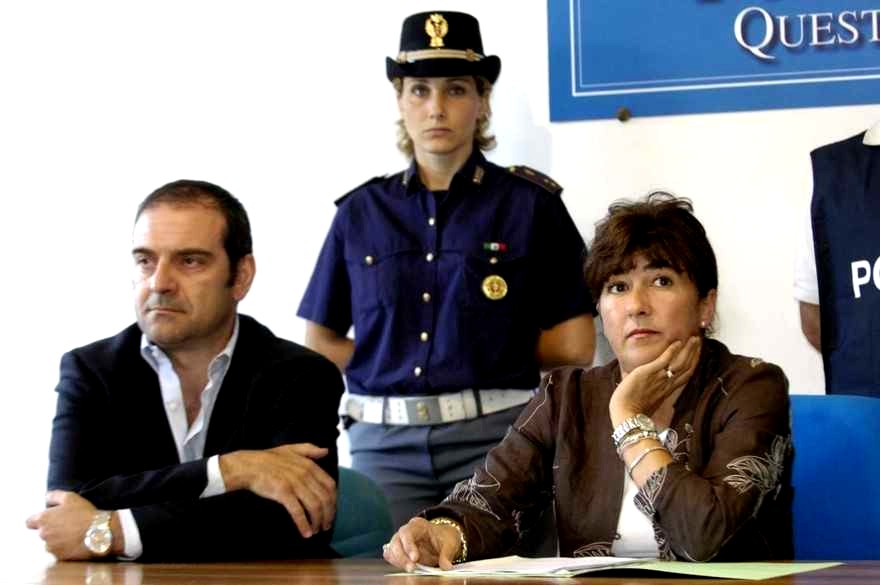
Dr Chiacchiera with Dr Comodi explaining reason for charges in another case
Overview Of This Series
Yet another vital translation which will be posted in the trial testimony areaof McCall’s great Wiki. This again is translated by the ever-dedicated main posterr ZiaK.
Although I graduated as a medical doctor I also graduated as a lawyer, and was often in courtrooms. For this post and the rest of the Chiacchiera series I am wearing my lawyer’s hat to point out what strikes me in Prosecutor Comodi’s questions, Marco Chiacchiera’s testimony, and the cross-examinations by defense lawyers.
Prior Preparations And Procedures
Under the Italian Code, before the beginning of the trial phase in Italy, the parties file a brief, detailing all evidence they want to present ““ the parties have to indicate by name every witness and precisely what these will be asked. The aims include creation of a Record of Admissible Facts.
Also under the Italian Code, both the defendant and the prosecutor can cross-examine each other’s witnesses. The Judge may choose not to admit any testimony that appears patently superfluous, reject irrelevant or improper or irregular questions ““ such as leading questions, and Inadmissible Hearsay ““ and also ask questions to the witnesses and experts.
Ground Covered In Dr Chiacchiera’s Testimony
- (1) He found Knox and Sollecito uncooperative when he asked them questions.
(2) Saw evidence contradicting any lone burglar theory and indicating that the “break-In” to Romanelli’s room was faked.
(3) Phone records and the police investigation into the accused phone activity the night of the murder.
(4) Discovery of pornographic magazines at Sollecito’s house.
(5) Details of how the large knife, Exhibit 36, was collected from Sollecito’s and the evidence that it is the murder knife.
My Assessment Of This Court Exchange
It is immediately obvious to me that this witness is a skilled witness; as such, and given his deep hands-on involvement in the immediate investigation this witness’s testimony is credible. My assessment therefore is that this was a very good and unflinching witness and that Dr Comodi shows no signs of leading the witness or seeking other than a truthful record.
I have seen prosecutors examine witnesses differently but dont believe the resultant record would have been superior. This would have stood up well in any American court.
(GCM=Giancarlo Massei; MC=Manuela Comodi; MaCh=Marco Chiacchiera; GB=Giulia Bongiorno; DD=Donatella Donati; CP=Carlo Pacelli; LG=Luciano Ghirga; CDV=Carlo Dalla Vedova; FM=Francesco Maresca)
Public Prosecutor Comodi [MC]
MC: Dr Chiacchiera, you carried out your duties where, when, at what moment of the events?
MaCh: I was and am the director of the Organized Crime Section of the Flying Squad and I am the vice-director of the Flying Squad. The Organized Crime Section is a branch of the Flying Squad that deals with “¦ the term, I think that in this place [i.e. the court] it is enough to say that it deals with organized crime. However, I am also the vice-director of the Flying Squad, for which [reason] I deal with, in the case of need, everything that is necessary [for] the various aspects.
{Witness supplies 5 items of relevant information that Examiner should elicit at beginning of examination.}
MC: Can you tell the Court how you became aware of events, who called you, when you became involved?
{Examiner asks another triple-question}
MaCh: Yes.
{Witness simply answers question as worded by Examiner}
MC: For now, start to tell us, then maybe I will intervene [NdT: i.e. interrupt with further questions] if necessary.
{Examiner, asking no Q, instructs witness, suggesting provisional forbearance if witness does not make interruptions necessary.}
MaCh: On the fateful day, at around 12:33, I had gone to the cemetery with my mother. The operations room called me immediately after the discovery of the body.
{Witness begins appropriate narrative response, but Examiner interrupts}
MC: So the 113? [NdT: 113 is the Italian State Police emergency number]
{Examiner interrupts witness with a Q, suggesting witness's receipt of call from an emergency number, but suggests wrong source-number}
MaCh: 110. The operations room of the Questura called me, and informed me of the happenings in an initially obviously very summarized manner. They said to me that there was a suspicious death, a young woman who lived in via della Pergola. I rushed to the place directly in my mother’s car. I didn’t stop by at the Questura, I didn’t go to get the service [i.e. police] car. I got myself taken to via della Pergola. We took about 15 minutes from the cemetery to there, ten fifteen minutes. In the meantime, I phoned the deputy Commissioner Napoleoni, in the temporary absence of the director, Dr Profazio, who arrived later, who was “¦ he was enjoying a period of leave, and with deputy Commissioner Napoleoni we arrived almost at the same time. We arrived almost simultaneously at the premises. Forensics, too, arrived almost at the same time at the premises.
{Witness supplies correct source-number and resumes interrupted narrative response}
MC: The Perugia Forensics?
{Examiner questions witness's correction, as if to verify and to ensure accuracy of court's record}
MaCh: The Perugia Forensics, I highlight, yes.
{Witness emphatically agrees with Examiner's question}
MC:”‹[They were] alerted by you, or ...?
{Examiner pauses mid-Q, inviting witness to guess complete Q, or is interrupted}
MaCh:”‹Alerted by the operations room, and also alerted by me.
,
{Witness responds to invitation, or interrupts with A to assumed complete Q}
MC:”‹So you arrive, and who do you find?
{Examiner's 1st simple Q.}
MaCh: “‹I found there ... there was already deputy Commissioner Napoleoni, there were also a few of Meredith’s co-tenants. There was Amanda Knox, there was Raffaele Sollecito. There were two young men who were, I believe, the friend of the boyfriend of one of the co-tenants. In short, there were a few people who had already been inside the house. There was the Postal Police.
{Witness answers Q in reasonable detail}
MC:”‹In the person of”¦?
{Examiner seeks more detail re specific Postal Police Personnel}
MaCh: “‹Battistelli and another of Battistelli’s colleagues. Inspector Battistelli, with whom there was immediately a discussion in order to understand what were the reasons for his intervention there, because it is not normal to find the Postal [police] in a crime of this sort. And he explained to me immediately what was the reason for his intervention. The origin of the, shall we way of his intervention, was due to the discovery of a pair of cellphones in a period of time, I believe, of an hour, [or] two, I don’t recall clearly, that were one in the name of one of Meredith’s co-tenants and one in the name of, later it [sic] “¦ I mean the SIM [card], obviously, the cellphones’ SIMs, the cards, they were in the name of a co-tenant and the other in Meredith’s [name]. The co-tenant, however, then told us, we then ascertained that both of the cellphones in fact were used by Meredith. And already that was, how shall we say, a first detail on which we began to reflect because, in fact, that was an element than in some way made us [become] immediately occupied/involved from an investigative point of view.
{Witness responds to Q and includes relevant amplifying narrative, anticipating probable future Qs re cellphones}
MC: “‹So, excuse me, also if the Court already, shall we say, knows this, because others have reported it, on this point however, where were the cellphones found?
{Examiner seems to interrupt with simple Q to clarify specific relevant fact not yet reached}
MaCh:”‹Inside the garden of a villa that is in via Sperandio.
{Witness responds appropriately}
MC:”‹In via Sperandio.
{Probably a Q, but implicitly inviting more specificity}
MaCh: “‹A villa that ... I am Perugian, [and] honestly, I didn’t even know there was a villa there. I’m Perugian, and I swear that I would have sworn [sic] that behind there was a wood.
{Witness flounders, seems unable to be more specific}
MC:”‹A field
{Probably a Q, but implicitly inviting more specificity}
MaCh: “‹It [was] the first time that I went in behind there. Instead, I see a marvelous old mansion with an enormous garden that gives ... that is almost adjacent to the street ““ the street that leads towards Ponte Rio. Anyone from Perugia understands me maybe.
{Witness seems to be in informal conversational mode}
MC: “‹From the structure of the fencing/enclosure, could you tell, shall we say, whether it was possible to throw these cellphones from the street, or whether it was necessary to enter the garden itself?
{Examiner engages witness, and asks Q to clarify how cellphones got into that garden}
MaCh: “‹Yes, obviously, we checked that. In fact, immediately, in short, the detail that seemed, how shall we say, of great investigative interest was that [very point], besides other details that I will go [into] a bit [sic], so to speak, also to give the impression of what the immediate impact was that we saw in the moment when we found ourselves in a situation of this type. So, deputy Napoleoni immediately entered inside the house in order to check it for herself. I did it [entered] shortly afterwards, also because [as] you will imagine that in that moment whoever was there had to notify all those who [sic], amongst whom Dr Mignini who was the Public Prosecutor on duty, and immediately give orders so that the correct checks are carried out. Because it was not just a crime scene that had to be analysed immediately: there also had to be, how shall we say, correlated with the information that we had got from via Sperandio ““ because the entry of the Postal [police in the case] originated with via Sperandio. And so we immediately asked ourselves: “Ah, what are these cellphones belonging to poor Meredith doing inside the garden of a villa?” And then And then immediately after, we asked ourselves, obviously, what might be the profile of the possible, or probable, murderer, and we discussed/talked about the crime scene. The crime scene immediately seemed fairly strange to us, if you wish [NdT: literally “if we wish” in Italian, but meaning the same as “shall we say”, “if you wish”, “so to speak” etc.]
{Witness responds to Q with detailed narrative}
MC:”‹Why?
{Examiner asks ambiguous Q, probably wrt crime scene seeming "fairly strange "}
MaCh:”‹Because the door did not show”¦ the entry door to the villa did not show signs of break-in. The we checked “¦
{Witness seems to decipher ambiguity correctly, begins narrative response, but is interrupted by Examiner}
MC:”‹We are not talking about the villa on via Sperandio obviously?
{Examiner interrupts with Q, apparently not comprehending Witness's narratives}
MaCh: “‹For the love of god! It was called a “villa” “¦ (overlap of voices), let’s say the house, of the house on via della Pergola there was no forcing/break-in. We found a forcing on the window. The window is this one, on the side of the house. I don’t know if you’ve seen the house? Anyhow, it is this one on the side of the house that can be seen immediately when you come down the slope from the gate. Logically reconstructing the thing, a hypothetical prowler [NdT: literally “ill-intentioned person”] who entered the house, breaking the glass with a rock - because inside the room, which was Romanelli’s room, which was the, shall we say, hypothetical arena of the entry, was completely in utter chaos. For that reason, what should we have hypothesized? That the hypothetical prowler took a rock, managed to throw the rock; the shutters, the external ones, the external shutters were not “¦
{Witness is exasperated at Examiner's apparent incomprehension, is repeating his previous testimony, but is interrupted by Examiner}
MC:”‹The dark-green wooden ones?
{Examiner interrupts with Leading Q re colour of external shutters. Now begins a confused and confusing colloquy. The arrangement of Filomena Romanelli's window, with Outside, and Inside Shutters, the Broken-Glass-Frame in-between, and the glass-splinters on the window-sill is complicated and needs a picture-exhibit that the witness can refer-to; this is apparently not provided, leading to the confusions}
MaCh:”‹The dark-green wooden ones were half shut, for which reason [he] must have had an aim like “Pecos Bill” [NdT: a cartoon Wild West cowboy], takes aim and throws that rock, smashes the window. After, he climbs up and does a turn on the little slope, and has to clamber up towards the window on the smooth surface, it seems to me, that from the ground up to the window there are two and a half metres-three [metres]. And then would have said: “bah, in short” [sic]. Yeah, well, the thing seemed to us…. in short, the first hypothesis that the investigator normally does, finds a level of unlikelihood of this kind of happening. After which, we looked at the house and we saw that an entry of a potential prowler [ill-intentioned person], still reasoning on the hypothesis”¦
{Witness amplifies narrative response but is interrupted by Examiner}
MC:”‹Of theft.
{Examiner inappropriately interrupts, incorrectly guessing what witness was about to say}
MaCh: “‹Of theft ending badly. Of theft that then degenerates because the burglar in some way thinks that he will find no-one in the house and instead finds a person, and then it degenerates “¦ We saw that there were easier means of entry, without wishing to bore you, but behind the house there was the possibility of climbing in a much easier way, without being seen by people that might have passed in the road. Let’s remember that, in short, it was not very late; quite the contrary. Normally people passed there, for which reason, if [he] had done it, the thing would probably have been seen. That thing there, as an hypothesis, we didn’t immediately discount it, that’s clear, because it’s a good rule to never discount any hypothesis. But we immediately considered that it was not a priority.
{Witness corrects Examiner's wrong guess, amplifies and seems to end narrative response}
MC:”‹Dr Chiacchiera, I interrupt you. (The witness is shown an exhibit.)
{Examiner, seems to acknowledge her habit of interruptions without actually interrupting, while introducing an unspecified exhibit. This introduction seems very informal, because Exhibits are normally identified by an assigned title.}
MaCh:”‹Ah! I didn’t remember it as being so big.
{Witness recognizes unspecified exhibit}
MC:”‹Precisely! You saw it? This is the rock that ...
{Examiner engages witness, stating it is "the rock".}
MaCh:”‹Yes, but it has been some time I have not, how shall we say, yes, I saw it. Absolutely.
However, it’s big, it’s huge.
{Witness engages Examiner, commenting on how large the rock exhibit is}
MC:”‹Do you consider that it could be this?
{Examiner ambiguously (what are "it" & "this "?) asks witness's opinion}
MaCh:”‹I believe so.
{Witness seems to overlook ambiguity of Q with vague A)
MC:"‹I try "¦
{Examiner begins to speak but is interrupted}
Judge Massei [GCM]:”‹How?
{Court interrupts as if to ask Q how Examiner 'tries'}
MC:”‹It is this. Yes, it is this one that was collected, yes, that was found.
{Witness seems to confirm that exhibited rock is the rock found in Filomena's room}
GCM:”‹So the rock is shown. [NdT: an “aside” for the court records?]
{Court formally announces admission of rock-exhibit, seemingly trying to reduce confusion caused by informal dialogue}
MaCh:”‹Inside the room where we then found the rock…
??:”‹But what was the question about the rock?
{Witness amplifies that rock had been found in a room, but enquires re rock Q, exposing confusion caused by informal dialogue}
GCM:”‹If this was the rock. And the witness said ...
{Court begins explanation to confused witness}
MaCh:”‹I said yes. Yes.
{Witness interrupts Court - confusion reigns}
GCM:”‹You saw it? You saw the rock?
{Court asks witness 2 Qs, trying to clarify that 'it' refers to 'the rock' that witness saw.}
MaCh:”‹Yes.
{Witness confirms that witness had previously seen the rock introduced into court as an unlisted exhibit.}
GCM:”‹When you saw it, where was it?
{Court proceeds to clarify confusion re where the rock was when witness originally saw the rock}
MaCh:”‹The rock [was] in the room of Romanelli.
{Witness specifically testifies, for witness's first time, that when witness originally saw the rock, the rock was in Filomena Romanelli's room}
GCM:”‹How far from the window? Can you say?
{Court continues to seek clarification using double-Q.}
MaCh: “‹A few centimetres [NdT: “un palmo” = “a hand’s width”] from the window sill, under the window, from the wall where the window is.
{Witness testifies clearly in answer to Court's 1st Q of above double-Q.}
GCM:”‹So from the internal perimeter wall, from where the window gives onto it, a “hand’s breadth”. So 20 centimetres…
{Court apparently begins to seek verification of witness's testimony, but is interrupted}
MaCh:”‹Mr President ....
{Witness begins to Interrupt Court}
GCM:”‹... away from it approximately.
{Court finishes his interrupted statement}
MaCh:”‹Yes.
{Witness agrees with Court's completed statement}
GCM:”‹And this is the rock. You remember it.
{Court states his understanding in form of Qs.}
MaCh:”‹Yes, yes, yes, yes. That is the rock.
{Witness impatiently agrees with Court's understanding}
MC:”‹At least as far as size and colour [are concerned], it corresponds thus to the one that was collected [as evidence].
{Examiner makes statements in form of Q, seeking verification of resemblance of exhibit-rock to original rock}
MaCh:”‹At least as far as size and colour [are concerned], it absolutely corresponds. If it was collected, I think that ...
{Witness begins narrative agreement with statements of Examiner, but is apparently interrupted by Examiner}
MC: “‹Very well. WITNESS [sic? Should be MaCh?] and Romanelli’s room was a complete shambles. The clothes were on the floor, the glass was strangely on top of the clothes, the [glass] shards were strangely on top of the “¦ on the windowsill, let’s put it that way.
{Apparent Transcriptional confusion attributing to interrupted witness narrative the interrupting .statement of Examiner}
MC:”‹The outside one.
{Examiner seems to amplify statement of Examiner wrt which window-shutter witness had been referring-to}
MaCh: “‹The outside one, precisely. The one that is between the shutters and the shutters [sic. NdT: “imposte” in Italian, but this can also mean shutters, or flap, as in the inner “scuri” shutters, or he may mean the window-frame itself, with the window-panes, given his following description], the green shutters and the shutters, the broken ones in short, where the glass is. The shutters ““ the wooden ones. The rock was a bit too close with regard to the wall if I [were to] throw it from least two metres. Unless it was lobbed [i.e. thrown in a high arc]. But in that case it’s rather unlikely that it would smash the glass. For that reason, I repeat, in the context of immediate likelihood, this one “¦
{Witness agrees with Examiner that he was referring to "The outside one", continuing with narrative of reasoning, but is interrupted by Examiner…}
MC:”‹Yes, it’s true. These are considerations. However they are considerations, shall we say, that refer [sic], because they are reasoning/lines of thought that are formed in the “immediacy” of the events [NdT: i.e. “in the immediate aftermath”. NOTE: throughout the text, a number of speakers use “immediatezza” (lit. “immediacy”) to convey a number of meanings, from “in the immediate aftermath”, or “in the immediate surroundings”, or “very soon after”, etc. I will translate them appropriately according to the context, without further explanation of the use of “immediatezza”], in order to proceed in one direction rather than another.
{Examiner, interrupting witness, apparently agreeing with witness's reasoning. While Examiner is apparently stating his own argumentative reservations re the possible evolution-in-time of witness's changing lines of reasoning, he is interrupted by Giulia Bongiorno, Sollecito defense lawyer:}
Giulia Bongiorno [GB]: “‹I never like to interrupt an examination [of a witness], however if one wanted, between the Public Prosecutor’s hypotheses, to do that [sic] of demonstrating that from a ballistic point of view it is not possible, then the ballistic expert should be called.
{GB interrupts Examiner to comment that Witness and Examiner are expressing opinions on Ballistics that require the testimony of a Ballistic Expert.}
MC:”‹But in fact, his considerations are not the considerations of an expert: they are the considerations of an investigator who made certain deductions in the immediacy of the events.
{Examiner argues that witness's testimony is that of an investigator's temporal train of thought.}
MaCh:”‹It happens to us too, at times, to reason/think rationally “¦
{Witness joins colloquy, amplifying Examiner's argument.}
GCM:”‹These reasonings/deductions, then determined your investigative activity in one direction rather than in an “¦?
{Court seems to invite further amplification by witness}
MaCh: “‹Yes, obviously, Mr President. I was trying to ... (overlap of voices) it is a premiss/basis to be able to then, how shall we say, reach ““ I won’t say conclusions ““ but in order to try to understand what our way of broaching the thing was, there and then. We had, I reassert, reasoned immediately also on via Sperandio. So the first thing, I may say, [was] the unlikelihood, or at any rate it was not the top priority hypothesis, the one of a prowler/ill-intentioned person entering. The open door without signs of break-in. But above all, a young woman who is [sic] probably killed in her own room, nude or almost nude, with a wound of that type, in a lake of blood, covered with a duvet. I repeat, the door was not smashed/wrecked, there’s a broken “¦ a window broken with a thrown rock, how can I say, it’s obvious that we immediately found this situation as “¦ (overlap of voices).
MaCh:”‹”¦ particular.
{Witness further amplifies narrative}
GCM:”‹You formed these considerations, and what did they lead you to?
{Court asks simple Q.}
MaCh: “‹That very probably the author or authors knew the person, or at any rate that the author or authors did not enter “¦ did not enter from the window-pane of that window.
{Witness responds with his conclusion that the authors of the faked break-in did not enter from the window-pane of that window.}
GCM: “‹Excuse me a moment, just to give some guidelines, but of the evaluations that the witness is expressing, obviously it’s not that they can be taken account of, however we will acquire them [for the trial files] in order to understand the investigation activities, the appropriateness of the investigations that were carried out, directed in one way or in another, there you go. However, maybe, “¦ there you go, yes, maybe if we can manage to keep with the bare essentials this will help everybody.
{Court proceedings seem to have been diverted into a free-for-all colloquy, with multiple participants chiming-in, and creating confusion. Court-President, GCM, now politely intervenes, apparently trying to restore order, ruling that the professional evaluations made by the witness, testified-to by the witness, should be admitted for the trial files. The appropriateness of the witness's evaluations can be dealt with separately and later.}
_________________________________________________
This segment of Chiacchiera’s Testimony re the Crime Scene, which he believed had been remodeled by the criminals to dupe Investigators into believing that there had been a burglary, committed by a single criminal, is paused here because it is so prolonged.
Analysis of Chiacchiera’s Testimony will continue in a future post.
Friday, August 15, 2014
Legal Timeline Of The Main Case, On Which The Next Ruling By Supreme Court Could Be Final
Posted by catnip
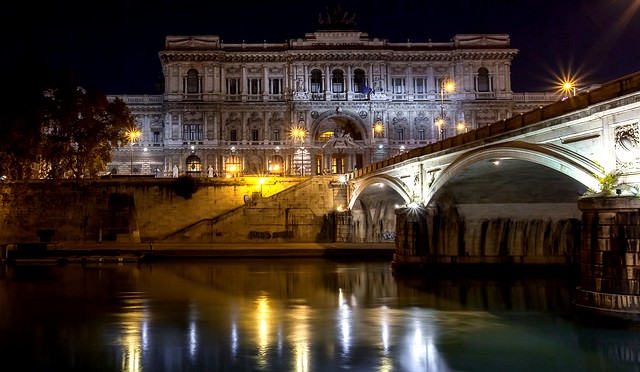
Cassazione (Supreme Court of Italy) seen from the east across the Tiber River
Todays Status
The Supreme Court is due to rule, possibly in the autumn, on what might be the final appeal by Sollecito and Knox on grounds which have not been published. Main steps prior to this:
November 2007
Meredith Kercher is found violently killed in her home while studying abroad in Italy. Her housemate, Amanda Knox, and Amanda’s friend Raffaele Sollecito, as well as Amanda’s boss, Patrick Lumumba, are arrested. A fourth person, Rudy Guede, is tracked down and also arrested. Patrick Lumumba’s alibi is confirmed and he is released.
December 2007, January 2008
Due process hearings authorise the continuation of preventative custody for the suspects, on the grounds of flight risk and possibility of tampering with the evidence.
October 2008
Preliminary Hearing Court, Perugia, Micheli presiding ““ after investigations have completed, the committal hearing finds there is a case to answer and remands Amanda Knox and Raffaele Sollecito to stand trial on the charges of :
- (A) aggravated murder in company of Meredith Kercher
(B) illegal transport of a knife from Raffaele Sollecito’s apartment
(C) aggravated sexual assault in company of Meredith Kercher (later folded into charge (A), on the grounds of being part of the same criminal event)
(D) illegal profiting by possession, to wit: of a sum of money approx. €300 and of credit cards belonging to the victim, and her mobile phones
(E) simulation of a crime, to wit: staging a break-in in Filomena Romanelli’s room
(F) Amanda Knox, in addition, calunnia, for falsely claiming, knowing him to be innocent, Diya Lumumba also called “Patrick”, of being the author of the murder
Rudy Guede is tried summarily “on the papers”, as he has requested the expedited trial procedure (“fast-track” trial) and is found guilty of charges (A) and (C), and not guilty of the theft, charge (D), and sentenced to life, automatically discounted to 30 years for choosing the expedited trial procedure.
December 2009
On appeal to the Court of Appeals, Perugia (4/2009, on 22 December 2009), his sentence is reduced to 24 years, automatically discounted to 16 years, the aggravating factors of the charges not being found by the court. His final appeal, to the Supreme Court of Cassation, First Criminal Section, is rejected (7195/11, hearing of 16 December 2010, reasons handed down 24 February 2011).
December 2009
Court of Assizes, Perugia, presided over by Massei ““ finds Amanda and Raffaele guilty of all charges (except the theft of the money and credit cards) but without the aggravating factors applying, and sentences them, with mitigating factors included, to 26 years for Amanda, and 25 years for Raffaele (the extra year for Amanda being for the calunnia).
October 2011
Court of Appeals of the Court of Assizes, Perugia, presided over by Hellmann (after a last-minute replacement) ““ trial convictions quashed, except for the calunnia charge against Amanda (charge (F)), where sentence was increased to time served (3 years); both prisoners released (4/2011, decision 3 October 2011, reasons handed down 5 December 2011).
March 2013
The Supreme Court of Cassation (25/3/2013) found the acquittals on charges A&C, B, D, and E to be unsafe, and annulled that part of the decision, remanding the matter to the Florentine jurisdiction, as per the usual cascade rules, for a fresh determination, and rejected Amanda Knox’s appeal on the charge (F) conviction and sentence.
January 2014
Court of Appeals, Second Chamber, Florence, presided over by Nencini ““ trial convictions on the non-calunnia charges upheld, therefore sentence increased to 28 years and 6 months for Amanda (11/13, decision 30 January 2014, reasons handed down 29 April 2014). All convicted parties to pay the relevant compensation to the various injured parties. Appeals to the Supreme Court of Cassation have been lodged.
Associated Timelines
See the posts here and here on the timing of events arrived at by the trial judges.
Friday, July 04, 2014
The Status Of The Various Computers In The Case And Whether Anything Nefarious Happened To Them
Posted by Sallyoo
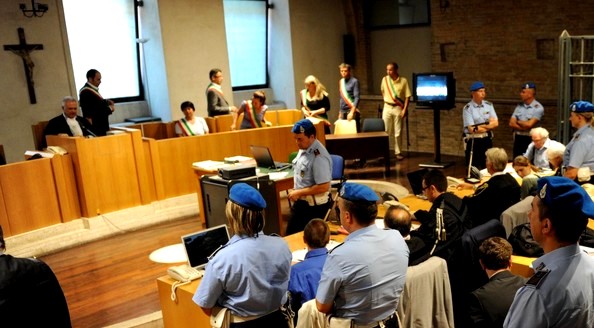
Trial court 2009 on one of several days computer and internet activity was testified to
1. Computer use as high-stakes evidence
There have been many arguments about computers during the case.
They began at the very beginning, and there is even now, in the final appeal by Sollecito to the Court of Cassazione, one remaining somewhat fantastical theory.
The facts surrounding the computer evidence collected by the prosecution have been obfuscated and contradicted by the defence using exactly the same techniques as have been used about the DNA and other forensic evidence in the case.
Blind the court (and the public) with hypotheses which very few people can follow, and use this ignorance to spread confusion and doubt.
Let’s try to shed some light.
2. Five key computers, plus
We know that Sollecito is pretty familiar with computers, he had two at the time, a MacBook and an Asus [1], both portables.[2] His apartment had a decent broadband connection, supplied, (using the Telecom Italia infrastructure) by Fastweb.
We know that both of these computers were sequestered from his apartment on the morning of Nov 6 2007, when Sollecito accompanied a squad of policemen despatched to search his apartment.
We know that the police removed, (on Nov 7), from the house in Via Della Pergola (where there was no telephone nor broadband service) a MacBook belonging to Meredith, a Toshiba belonging to Knox, and a portable computer belonging to Laura Mezzetti.
The police also took an HP portable from Lumumba’s apartment.
There is even another computer which the police already had possession of, and that is a Sony portable belonging to Filomena Romanelli. This computer Filomena herself had taken away from her bedroom shortly after the discovery of the murder, and which the questura, in the evening of Nov 2, required her to hand over to them because it formed part of the ‘crime scene’.
3. The police HD analysis begins
On Nov 13 a postal police technician (Marco Trotta) received a box containing five computers (two from Sollecito, Knox, Meredith and Lumumba).
On Nov 15, in the presence of Formenti, (a consultant nominated by the defence) Trotta took them apart (removed the hard disks) and attempted to make copies of the data recorded on them.
This is the point at which it is alleged the destruction of three hard disks occurred.
It is difficult to believe that this is the case. Not only because the equipment used had never before (or since) managed to trash a hard disk (and it had no problems with Lumumba’s disk) but also because of the state of Filomena’s computer, which never got anywhere near Trotta.
All of the computers had of course been in the hands of the squadra mobile for some days before being consigned to Trotta, allowing for the possibility of some earlier interference by some malfeasant policeman.
This isn’t likely, not only because Trotta insists that the computers were complete and superficially undamaged, and the hard disks factory sealed when he dismantled the computers, but also because of Filomena’s computer.
4. Filomena’s Sony machine
It is now time to go a little deeper into the history of Filomena’s Sony.
This was a fairly new machine, which she kept in a substantial computer carrying case. It was working perfectly on Oct 30 when she last used it. She had left it in her bedroom, the case standing upright beside her bed, when she went off to spend the brief holiday with her boyfriend.
She found it, still in the carrying case, lying flat in a pile of stuff under the broken window of her disturbed bedroom. [3]
The defence commissioned a Computer Expert Report, entered during the Massei trial, which talked about the reason for the data being irrecoverable on the three computers’ disks.
Their conclusion was that the electronic circuitry controlling the hard disks had, in all three cases, suffered damage, most probably due to an electrical overtension. The circuitry had been ‘fried’.
They were unable to be certain how or when this might have occurred, or to opine on whether it was deliberate.
Filomena, in the presence of Gregori, (another communications police officer), at the Questura on the evening of Nov 2 attempted to turn on her Sony. It wouldn’t work. The hard disk would not respond properly.
When she got it back on Dec 18 and gave it to a private computer technician, he said the control circuitry on the hard disk is ‘fried’. Exactly the same fault as had occurred on the other three, which we are expected by th defense to believe was either a deliberate piece of police sabotage, or proof of police incompetence.
5. The Sollecito computers
The important computers, of course, are those owned by Sollecito because he is, even now, still trying to force an alibi out of them.
The MacBook has been accurately interrogated to death, most particularly by a defence expert named Antonio d’Ambrosio who gave very clear testimony at Massei on 26 Sept 2009.
He was even generous enough to acknowledge that the investigations carried out by the postal police were correct, and well interpreted, and that he was able to uncover a little more information simply because he wasn’t limited by forensic protocols (and could therefore reveal information not visible to the Encase software used by the police) when he examined a copy of the cloned disk from the Mac.
Basically the only ‘news’ in this interesting testimony was an interaction with the Apple website at 00.58 on Nov 2, which he did consider a human interaction with the computer.
6. Activity on the Internet
Sollecito maintains he spent the whole evening and night in his flat. At first his story was that he was sending e-mails and surfing the web. This was quickly demolished by reference to the IP log supplied by Fastweb, the broadband supplier.
It’s necessary to get slightly technical here.
Most of what we call The Internet, and certainly everything which is called The Worldwide Web, including e-mail clients, subscribe to a protocol which (in shorthand) means everything is a Port 80 request.
The individual computer, via its router, contacts the ISP (Fastweb, in this case) and identifies itself by means of a unique IP address. The ISP then directs the communication to the IP of the website requested.
This is all recorded on the Fastweb network. It is certain that no Port 80 requests were made from Sollecito’s apartment (whichever computer he may have been using) between 18.00 on Nov 1 and 00.58 on Nov 2.
There are parts of the international communications network which don’t use Port 80 protocols. The most ‘innocent’ of these are Peer to Peer (P2P) networks ““ in widespread use for distributing and downloading music and video files.
Sollecito certainly availed himself of these services, using a program called Amule on his Mac. He had a folder containing downloaded files, which was accessible to the program, and thus also accessible to anyone in the world who wanted a copy of something which Sollecito had in this shareable folder on his computer.
If he wished to save the file for posterity, he would move or copy it from this accessible folder into his own archive.
Video files are large, and they take a long time to download. Clearly, to download a file, or to make your publicly accessible folder available, the computer has to be turned on and connected to a router.
If you use these file sharing services extensively, it implies that you keep your computer turned on and connected all the time. It seems likely that this was Sollecito’s habit.
Clearly, you need to automate this sort of transfer ““ often a large file will be accessed in part from one remote computer, and another part will be located on another remote computer ““ so you simply instruct Amule to get you a film, or a list of films, and you can walk away from the computer.
Even D’Ambrosio is unable to be certain that a human interaction occurred at 21.26 on Nov 1, or whether a pre-requested download of Naruto commenced.
However, no IP addresses are exchanged when connecting to a P2P network, and so it is impossible (from ISP records) to trace any traffic.
It is possible though, from the hard disk, to discover what has been downloaded and saved to a computer on a P2P network, and exactly when ““ but to distinguish an automated process from a user instigated one is not possible.
7. Computers and Hellmann appeal
Now we move onto the Hellmann appeal, where a report from this same consultant D’Ambrosio was accepted into the case files. I haven’t been able to find this report, and Judge Hellman doesn’t even refer to it in his sentencing report.
However, the gist of this D’Ambrosio report is included in the current ricorso (appeal) from Sollecito to the Court of Cassazione.
8. Computers and Cassation appeal
We hear a bit about screensaver behaviour, and quite a lot about post Nov 1 interactions overwriting earlier actions.
The major ‘fresh’ theory now depends on asserting (more than four times in the ricorso) that the postal police destroyed Sollecito’s Asus, and that this action has meant that Sollecito’s alibi cannot be proved.
The lack of any signs of interaction on the Mac can be explained (so we are informed) by the Mac and the Asus being networked together, using a file sharing utility named Samba, and if the (broken) Asus could have been accessed it might have shown that it had been controlling the Mac.
So the Mac would have been doing things at the command of its owner, but because the owner was interacting with the keyboard of the Asus rather than that of the Mac, these actions are undetectable on the Mac.
This is what we are now being asked to believe.
9. Conclusion and way forward
I think this is an accurate summary of the relevant parts of ‘computer evidence’ discussed, or deposited, during the hearings and in the ricorso. I look forward to any comments, clarifications, corrections, but above all, to any new theories about how and when the four hard disks got trashed.
From other sources there are an additional two hints at possible new or ignored evidence:
The BBC reported, on 14.03.2009, the following sentence. “A second computer belonging to Mr Sollecito also showed no activity but the suspect had himself admitted it had been broken before the crime was committed.” [4]
And then we have Sollecito, in his prison diary of 11.11.2007, being rather more than aware that his computer is not going to be useful to him as an alibi.
I have been very anxious and nervous in the last few days, but to see my father who tells me “do not worry, we will get you out” makes me feel better. My real concerns are now two: the first one derives from the fact that, if that night Amanda remained with me all night long, we could have (and this is a very remote possibility) made love all evening and night only stopping to eat… it would be a real problem [casino] because there would be no connections from my computer to servers in those hours…
No connections in those hours? Hmmm.
10. My references
[1] This computer is sometimes referenced as an Acer. In Trotta’s testimony (he is reading from notes) it is listed as an Asus, so I have used this name. There is only one computer whether it’s an Asus or an Acer.
[2] There is a reference to a non portable computer in Sollecito’s apartment (in the testimony of Popovic). This is the only mention of any non-portable (i.e. desktop or tower cased machine with separate monitor). Given the position from which Popovic saw the screen (on a desk, with Knox sitting in front of it) it seems likely that she was mistaken.
[3] Amanda Knox frequently refers to seeing Filomena’s computer on her desk after the ‘break in’. At one point in her testimony she changes her mind and corrects herself to change the computer to camera.
[4] http://news.bbc.co.uk/2/hi/uk_news/7943828.stm I have not found another source for this comment.
Wednesday, April 16, 2014
The Incriminating Bathroom Evidence: Visual Analysis shows the Footprint IS Sollecito’s
Posted by Machiavelli
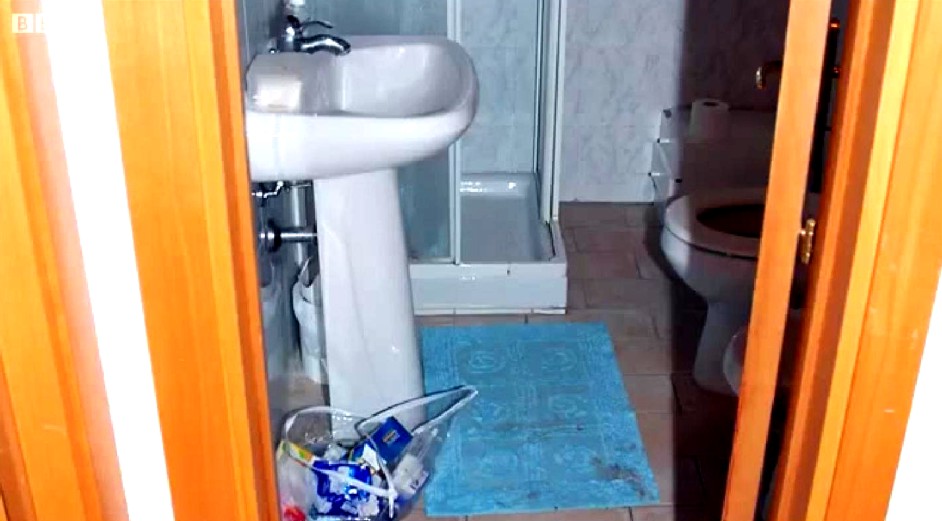
[Please click on each image for a larger and more high-resolution version]
The sheer depth and width of the hard evidence
The defenses really don’t want you to know this: in both width and depth, the full panoply of the evidence against Knox and Sollecito is absolutely overwhelming.
As we remarked in our post below there are far more and far stronger evidence points than UK and US courts normally require for conviction. But only the trial panel of judges observed anything like their full array.
The 2010 Massei Trial Report (which the Nencini Appeal court validated this past January) is a SUMMARY of what was presented to the judges in the courtroom. Those presentations in court were in turn something of a SUMMARY of the hard evidence buried in all the evidence files and the minds of witnesses.
Italian media SUMMARISED for Italians what was to be seen in the courtroom and to be read in the Massei Report. They were barely able to do even summaries for the 1/4 of all the trial hearings that were not open to the media or the public.
UK and US media for the most part didn’t even bother to provide comprehensive summaries (the very fine on-the-spot reportings of Andrea Vogt, Barbie Nadeau and Ann Wise were the main exceptions).
So in effect people in the UK and US attempting to follow the story didnt for the most part receive even a summary of a summary of a summary!
Not one US or UK newspaper or TV network translated the Micheli Report, or the vital Massei Report, or the Supreme Court appeal, or the Supreme Court outcome - only the (mostly professional) translators on PMF dot Org did all that translation.
This post is another example of how far down - beyond even Massei - it’s possible to drill into the evidence, and see it still hold up.
Some past posts on TJMK drilled down to similar depths, on the knives, on the DNA, on the mixed-blood traces, on the phone-events, on the motives and psychologies, and so on. All that evidence too all held up.
Visual analysis of the bathroom-mat footprint
This post mainly consists of high-resolution pictures and measurements. Presented like this, the pictures and measurements largely speak for themselves, and show the real strength of the bathroom-mat footprint evidence.
You will see that as SomeAlibi previously concluded using other methods, this footprint was quite undeniably Sollecito’s. It bears no similarity at all to Rudy Guede’s.
Please click on all images for larger versions in scalable PDF format
1 . [Below] the bathmat and the print, with measurement reference
2 . The bathmat print and the surrounding area
3 . The bathmat print (photo from Polizia Scientifica).
4 . The bathmat print, with vertical and horizontal sizes, from Rinaldi’s report
5. The bathmat print, photo with enhanced contrast.
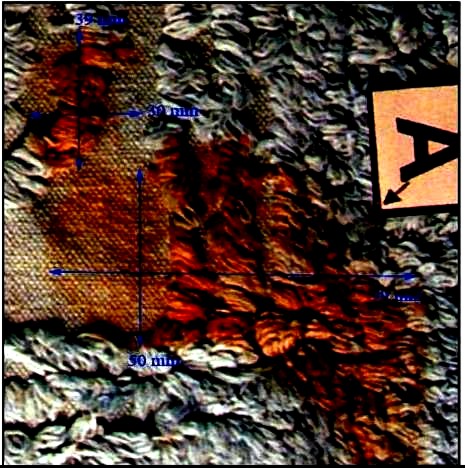
The photo above was modified by highly enhancing contrast.
6 . Enhanced contrast helps to spot some features
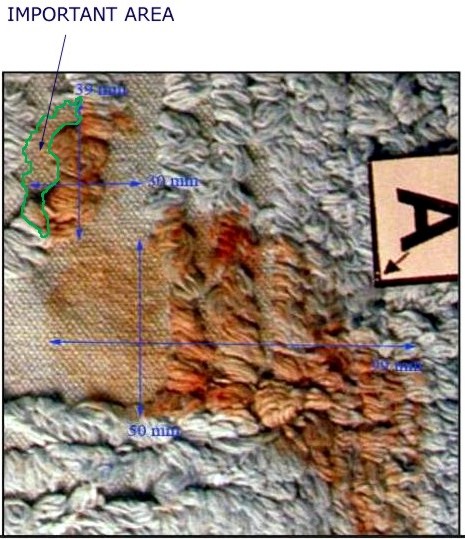
Contrast may help to highlight especially some parts of the print outline.
For example the area on the left labeled as “important area” in the picture (which was “forgotten” in the notorious photo elaborations disseminated by the ‘Friends of Amanda’ group), shows the actual left outline of the “˜big toe’ of the bathmat print.
The toe includes the area indicated in this picture (here the picture is shown again in its original colours).
7. The bathmat, with enhanced contrast
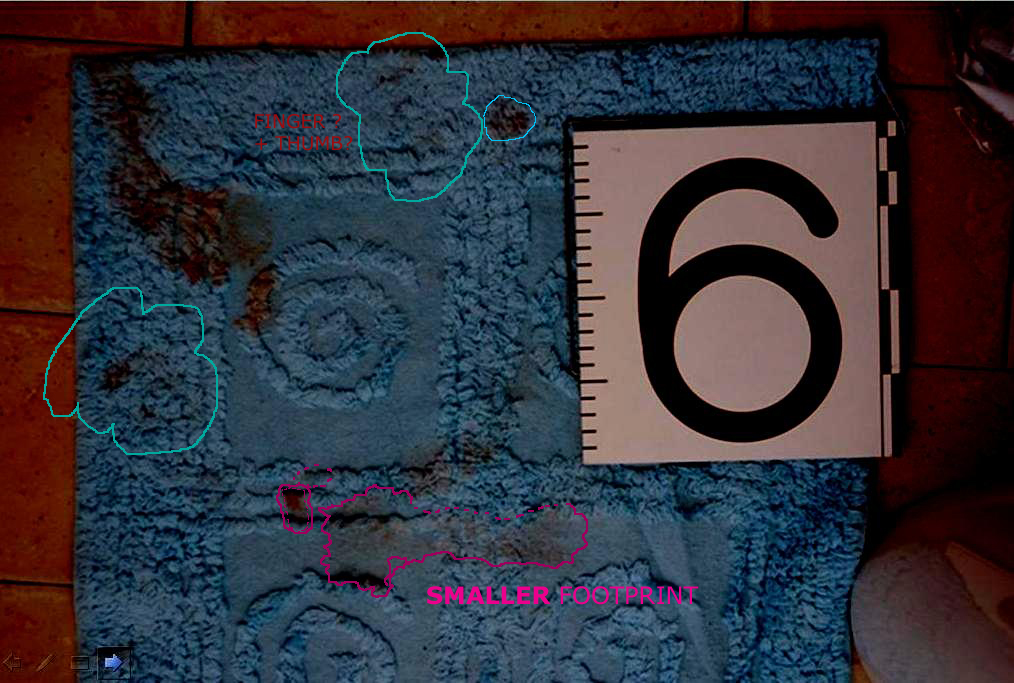
The contrasted image is showing the presence of other stains
There are other stains on the carpet (about another 10, factually situated in one half of the mat area), and also there shows a second diluted footprint (apparently from a foot of smaller size).
8. The selection of a set of red colour shades, outlined by an automatic outline generator
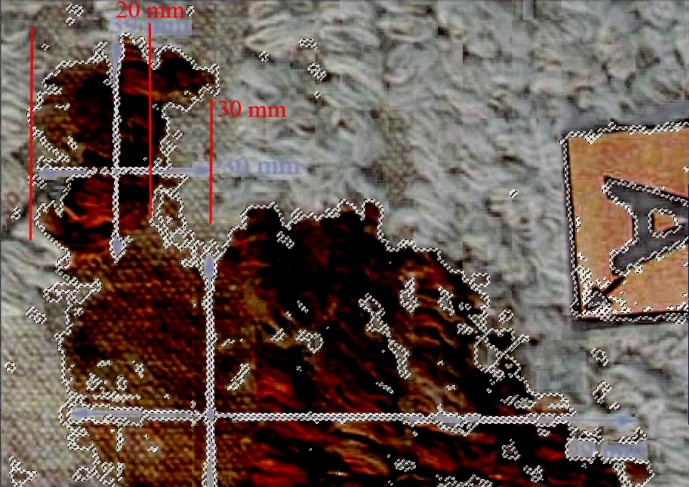
Shows the shape and the possible “˜outline’ of the stain
Reference measurements indicate the width of the “˜big toe’ in millimetres.
9 . A hand drawing of the outline (detail).
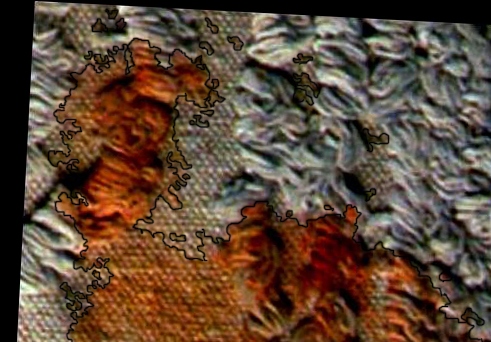
The photography above was modified
The modifications are: +28% contrast, -8% luminosity, + 20% colour saturation, from the original.
An outline has been drawn manually on the photoshop image, trying to be as faithful as possible to the actual stain.
You can notice that, apart from some minor “˜disputable’ very faint areas (such as the area between the toe and the metatarsus) there are only minimal differences between an automatically generated outline and a manually drawn one.
The shapes of the “˜big toe’ are extremely similar in both contours (images 8 and 9), in fact all meaningful features are basically identical.
We consider this manually drawn outline as good for comparison.
10 . The complete hand-drawn outline
11 . Minor detail: small dots separated from the main stain
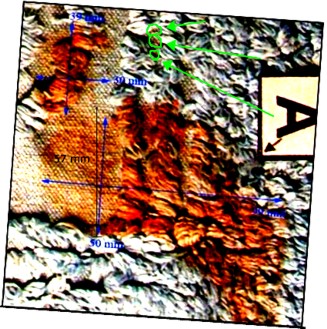
Observe the small red ‘dots’ in the picture above
Although we can’t draw any conclusion about their possible significance, we note the existence of these very small “˜spots’ of a faint red colour shade, separated from the big stain.
They are detected by the computer generated outline above, and that we also see as distinguishable with the naked eye thus we considered them in drawing manually the outline.
We don’t draw any conclusion about them; but because of their sensitive position (they may suggest a “˜small toe’ mark) we take note of them.
The green arrows in the picture point out their position (green circles).
12 . An image in electronically modified colours
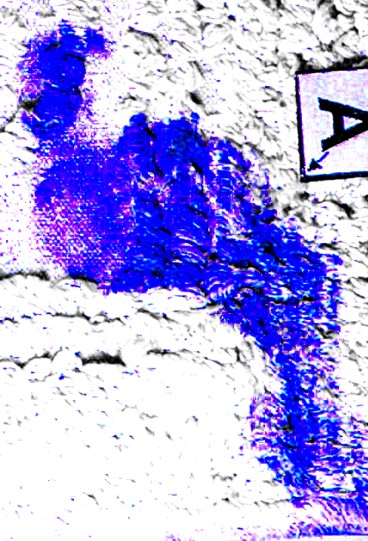
Distribution and intensity of the colouration
As a part of the preliminary study of the stain, we also produced this image above where the computer assigned an artificial colour to an array of shades of ‘red’, thus allowing to further isolate the stain from the background for further assessments about its shape.
This picture shows the distribution and intensity of the colouration. (note: the existence of some above mentioned tiny marks is recorded by this technique too)
13 . The bathmat has a spiral-shaped relief decoration
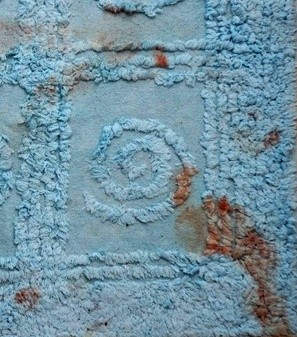
The footprint’s toe obviously balancing on top of the relief decoration.
We think the outline of the “˜toe’ mark of the bloody footprint is affected by the shape of the decoration, in particular the missing part of the toe on the right side, which is remarkably coincident with the margin of the decoration.
So that on that side there is a striking correspondence between the outline of the “˜negative area’ ““ the fabric surface around the spiral, which is lower ““ and the big toe’s outline
This indicates that the outline of that mark on that side was affected by the decoration margin, thus the print there has a “˜missing part’. So the “˜crooked’ bloody area in fact follows the margin of a larger toe.
Because of such coincidence, we can logically assume that the actual shape of the big toe mark appears to be part of a big toe, with larger surface which left its print only partly because part of its surface did not have contact with the fabric, in correspondence of the “˜negative area’.
14. The “negative area”
15. Mat decoration in relief and the toe mark
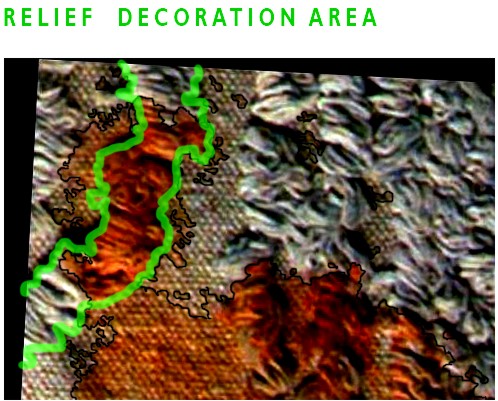
Observe above one single, unitary stain
The remarkable coincidence between the outlines of the decoration in relief and of the toe mark is shown in the picture above.
The rough contour of the print obtained through a smooth curve highlights the shape of the big toe.
Part of the relief decoration outline coincides with the toe mark outline, which shows, highlights and explains how all parts of the red toe mark, that you can see left of the relief decoration, they all belong to one single, unitary stain.
Thus we can deduce that the “missing” area on the right of the toe is determined by the decoration, and coincides with the negative area.
16. Picture (by Kermit) showing a rough shape of the stain
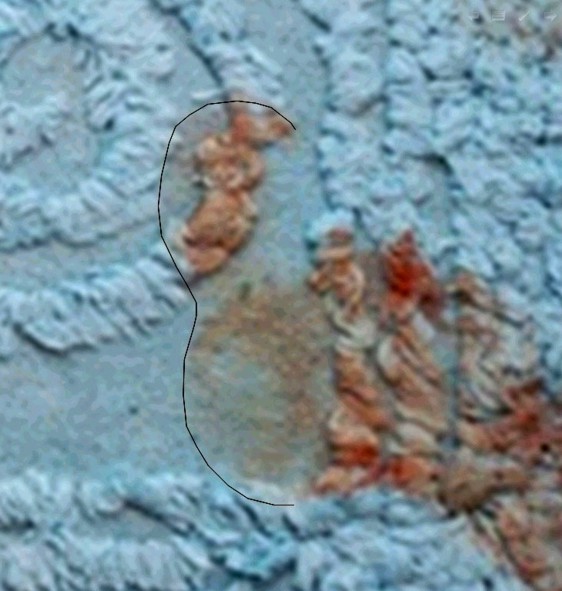
Observe shape, curvature and size
This drawing by Kermit above highlights the rough shape, curvature of left margin and overall size of the big toe.
17. Rudy Guede’s sample print
A copy of this picture together with one of Sollecito’s print at the same scale will be used for comparisons.
18 . Raffaele Sollecito’s sample print
A copy of this picture together with one of Guede’s print at the same scale will be used for comparisons.
19. Part of Rudy Guede’s sample print with Rinaldi’s reference measurements
20. Part of Sollecito’s sample print, with Rinaldi’s reference measurements:
21. Bringing all photographs down to the same scale
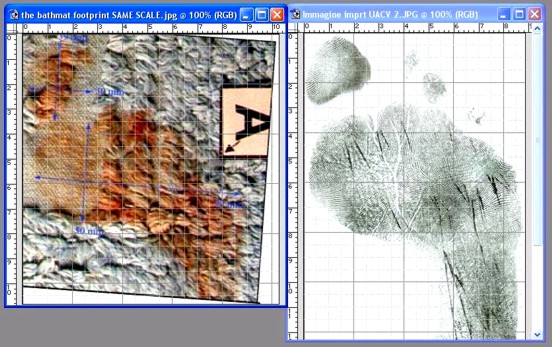
An accurate exercise of scaling was done
This was based on Rinaldi’s referenced pictures. Each one of the Rinaldi’s sample pictures has multiple measurements on several points of reference which allow a high precision determination of their scale and sizes, and thus comparison at the same scale.
In order to further increase scaling precision, the scale was calculated previously and separately for each comparative measurement in the three photos; this was done multiple times for each measurement and the average was picked in order to reduce error as for statistical measurement method.
The resulting final error in the scale is extremely small, far below a threshold of significance that could affect comparison (which was set arbitrarily at 1%, but it’s probably significantly higher, while the actual error is much lower).
In other words, the scale error that may affect your screen pictures will be definitely smaller than any possible perceivable (either significant or tolerated) difference that would be noticed or that may affect the attribution of the stain, when this is compared to the sample.
22. The hand drawn outline is shown again here
23 . The outline (matched scale) overlapped on Sollecito’s sample footprint
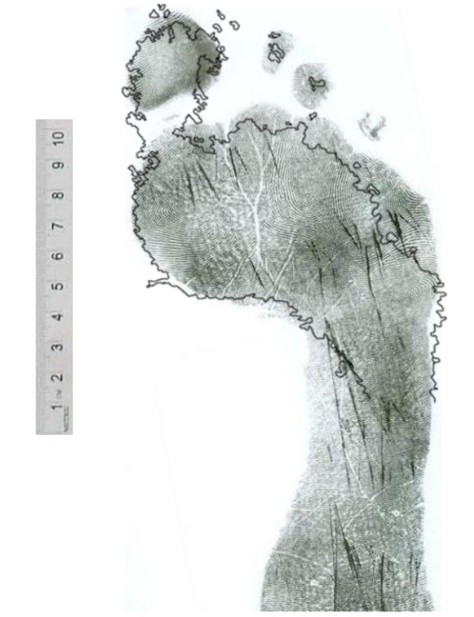
The array of compatibilities with Sollecito
The bathmat stain does not seem to have major incompatibilities with Sollecito’s print; it shows rather an array of compatibilities that can be perceived visually.
One interesting feature is the shape, size and position of a ‘big toe’, that appears as a remarkable coincidence; the toe also has a kind of cleft (see 28 below) on the curvature of its left margin. Another outstanding coincidence is the curvature of the plantar arch on the left.
24 . The same outline overlapped on Guede’s footprint
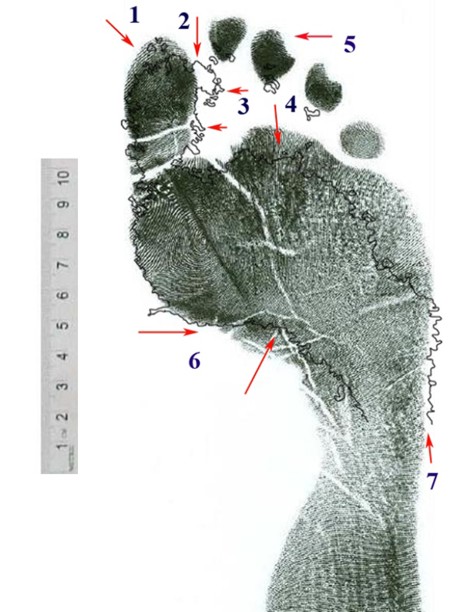
Compare with Guede’s - matched scale.
If you look at the overlapping of the stain outline (see pic 22.) with the sample of Guede’s print (see pics 17. 19.), you may notice 7 major differences, showing a failure of compatibility. Those differences are indicated by numbers (1-7) in the picture .
Each one indicates an area of major difference between the outline of the bathmat stain and the outline of Guede’s sample print. Those measurement differences are remarkably larger than those that can be detected on the overlapping with Sollecito’s sample print.
On the other hand, the compatibility between Sollecito’s print and some very peculiar aspects of the bathmat print (such as a 30mm wide and short toe) were absolutely remarkable.
The differences between the bathmat stain and Guede’s print are :
1) Toe mark of stain is significantly SHORTER than the big toe in Guede’s sample print (a difference of about 7 millimetres). Some people may want to attempt an objection, by suggesting that such a difference may be just a consequence of the position chosen for the overlapping, that maybe the bathmat print was just positioned too low in the picture, the problem may be solved by shifting it up about 7 millimeters so as to make the tip of the bathmat toe ‘coincide’ with the tip of Guede’s print toe.
However, such objection wouldn’t work; it’s a wrong argument. In fact the only possibly correct position for overlapping the bathmat stain outline is determined by the left curvature of the ball of feet and plantar arch (the area of the picture near number 6), which is by the way the most clearly outlined part of the bathmat stain. If you shift the bathmat stain upwards, the outline will miss the match with the curvature of the left margin of the ball of the feet. You will notice that the plantar arch in this area is already very incompatible with Guede’s plantar arch. It tends to become even more incompatible the more you shift the bathmat stain outline towards the toe.
The problem has no solution, since the more you shift the stain outline upwards (in the direction of the toe) in an attempt to make it look more ‘compatible’ with the length of Guede’s toe (or with an upper margin) the more it will become incompatible with the plantar arch. In order to limit the incompatibility of the plantar arch, and in order to keep an overlapping of at least the left margin of the ball of the feet, you need to place it as shown in the picture, this is the position of ‘maximum’ compatibility between the bathmat stain and Guede’s print. Conclusion: the bathmat toe is too short.
2) Toe mark of stain is TOO WIDE (30 mm). It is much wider (30 mm) than Guede’s toe. The number 2. indicates the protruding mark at the upper right, the mark which Giulia Bongiorno desperately insisted on calling a “second toe” mark. In fact, not only would the mark miss completely any hypothetical Guede’s ‘second toe’ in any possible position of the print; also you may notice (highlighted by pics 8. and 9.) how it is not a “mark” itself, but actually it just part of the same area which is entirely continuous in shape and coloration with the rest of the toe mark, and - the most remarkable feature - its right outline is coincident with the outline of the spiral-shaped relief decoration, so that you can reasonably conclude that it is determined by that (the missing area at the lower right of the ‘big toe’ is determined by the existence of the “negative area” of the bathmat decoration).
Conclusion: the bathmat stain has a wider toe mark, however one likes to call it (“big toe”, or “big toe + second toe”) that fails to match any possible part of Guede’s print. The bathmat print is clearly different and incompatible with Guede’s print. It simply cannot be overlapped to any part of Guede’s sample print. Such area is a very significant difference that points outright to incompatibility between the stain and Guede’s print.
3) The toe mark is larger also in the area located at the lower portion of the toe. The toe of the bathmat print in fact has a ‘right margin’ which actually has some additional small marks, small drops protruding towards the right, like droplets maybe produced by the wet cotton fibres of the part in relief which protrude towards the right. This tends to suggest the toe area of the stain may in fact be considered wider: the object that produced it was definitely wider than 22mm, in this area of the toe as well. So also a look at this area confirms that the bathmat stain is wider than 22-23 mm (more towards 30 mm) not just when measured at the upper corner (number 2.) but also at its “lower” parts; here, the small marks caused by the liquid suggest that a larger surface has squeezed liquid from some fabric threads leaving some trace also on the lower area.
4) Bigger incompatibility of Guede on the metatarsus front outline. This area is the front outline of metatarsus: the stain is almost 1cm shorter than Guede’s metatarsus. This happens when you chose the overlapping so as to make the left outline and plantar arch (6.) of metatarsus coincide, as in the picture. Sollecito’s sample print also shows some difference from the stain in this area (pic. 23.) but the difference between the stain and Sollecito’s print is significantly smaller than what you can see in Guede’s print.
5) There are NO SMALL TOES in the bathmat stain. Small toes are completely absent from the bathmat stain (while the tiny blood marks around the stain don’t coincide with their expected position if it was Guede’s print). Such lack of small toes is a peculiarity of the bathmat print. This is a remarkable difference from Guede’s print, and at the same time, a considerable analogy with Sollecito’s print. In fact one outstanding feature of Guede’s print is the evidence that Guede places a big load of weight on his small toes while instead Sollecito has a posture with a weight distribution with the contrary tendency, and obviously he almost does not touch the ground with his small toes.
Thus, Guede’s small toes are all very well pressed on the ground and thus, we can reasonably infer they are somehow naturally likely to get wet if he steps on any wet surface, and anyway they should get wet for sure if the foot is immersed in water or washed (the foot that left the bathmat print must have been immersed in bloody water). The murderer supposedly washed his foot then stepped on the bathmat. In order to attribute the print to Guede we should assume that Guede “forgot” to touch the carpet with his small toes (while instead he puts a lot of weight on them) or that he managed to not rinse them.
6) The outline of the stain has a PLANTAR ARCH that COINCIDES, by curvature and angle, with the plantar arch in Sollecito’s print, while instead it is very different from the plantar arch of Guede’s print.
7) The stain is larger than Guede’s print metatarsus as visible in the right area of the stain. The difference is rather significant, almost half a centimetre, that is bigger than the difference with Sollecito’s print which instead coincides for a trait. This difference cannot be “solved” in any way since, even if one wanted to claim that the scale is wrong and that the stain should be sized down, this would make the toe, already too short (as in 1.) become even shorter.
If instead the toe length is adjusted the metatarsus becomes even less compatible with Guede. We recall that Massei found that Guede’s feet had a print overall more slender than Sollecito’s.
25 . Other features:
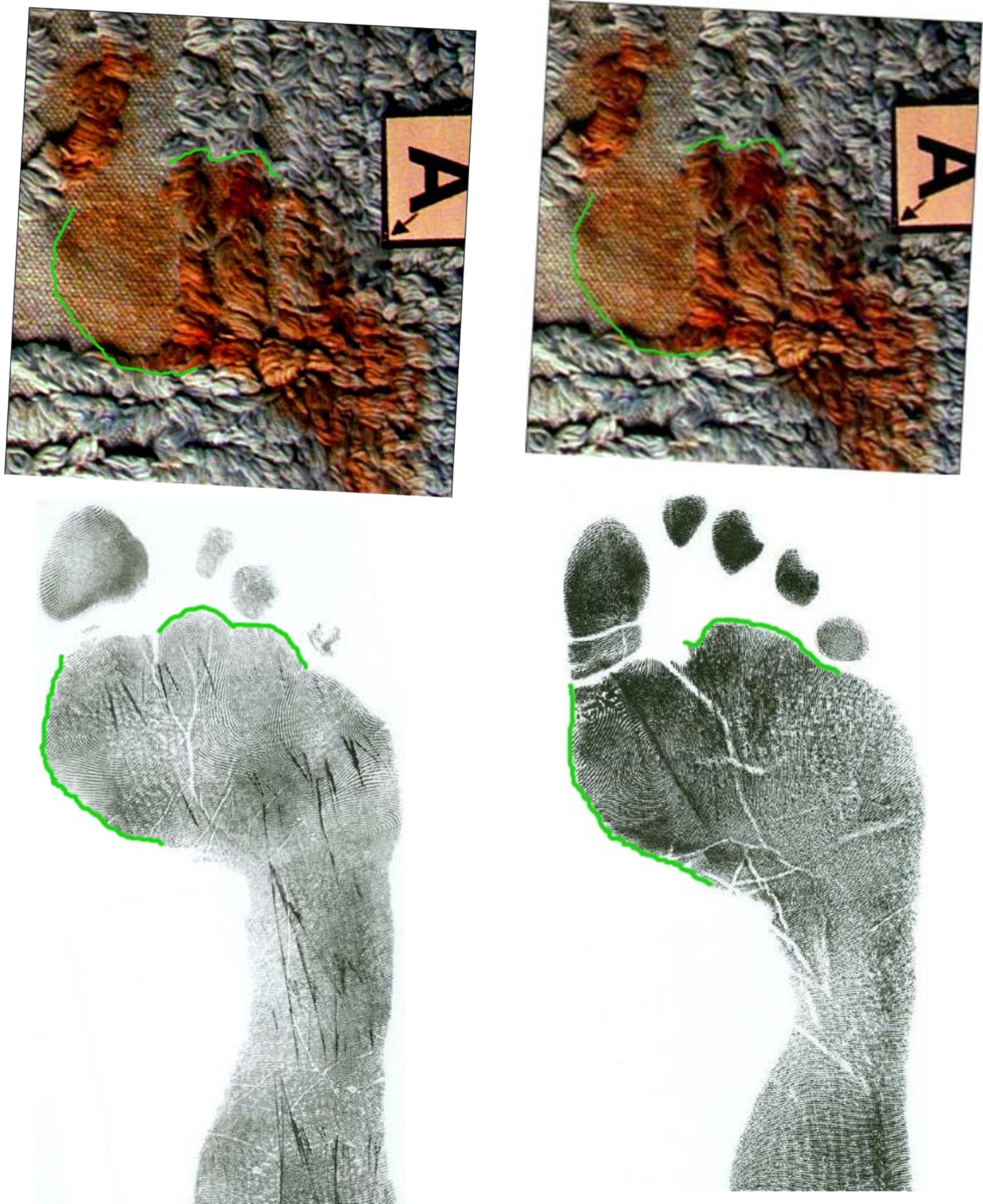
Curvatures of plantar arch are very different
The plantar arch curvature, highlighted in two different drawings (the second highlights also the upper outline “hunches”); the plantar arches in the two sample prints of Sollecito and Guede are shown below. The curvatures of plantar arch are very different.
26. The outline curvature generates different angles
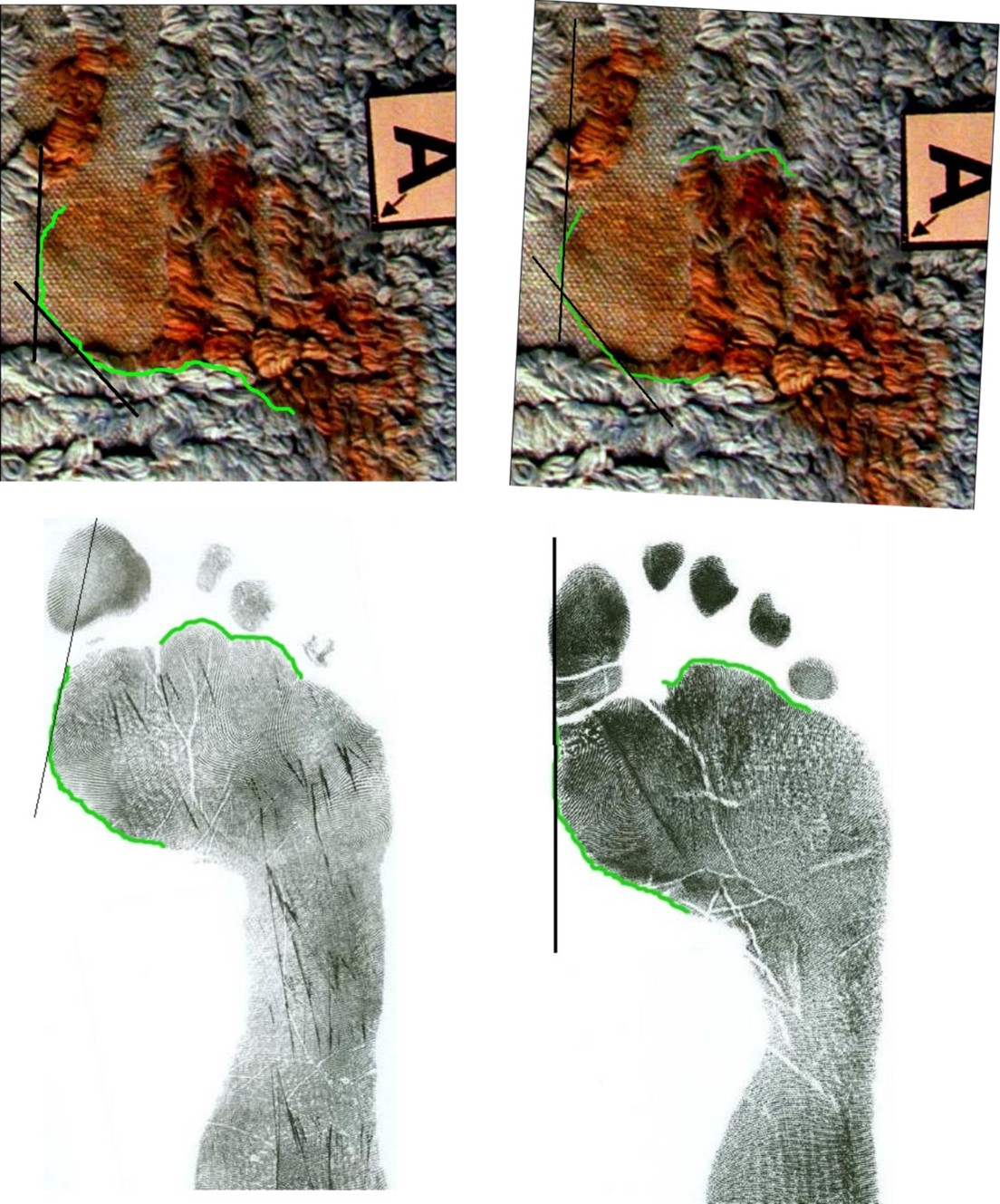
Sollecito’s and Guede’s plantar arch curvatures have very different angles. Also the left outline of metatarsus maintains a different curvature. Sollecito’s outline has an angle (see outline tangent) intersecting the toe (the metatarsus has a “bunion”); in Guede’s print there is basically no intersection, the outline and the toe form almost a straight line.
27 . Plantar arch curvature angle differs between Sollecito and Guede
If you consider the vertical axis of the sample footprint, and its orthogonal line, you may notice how the plantar arch curvatures of the two prints accomplish different angles: the two angles are VERY different, not just three or four degrees.
The (too) narrow angle of Sollecito’s plantar arch probably has a relation with the protruding outline and angle seen in pic 26., and seems related to a hallux valgus (which Guede does not have).
28 . The “cleft” on the left side of the stain
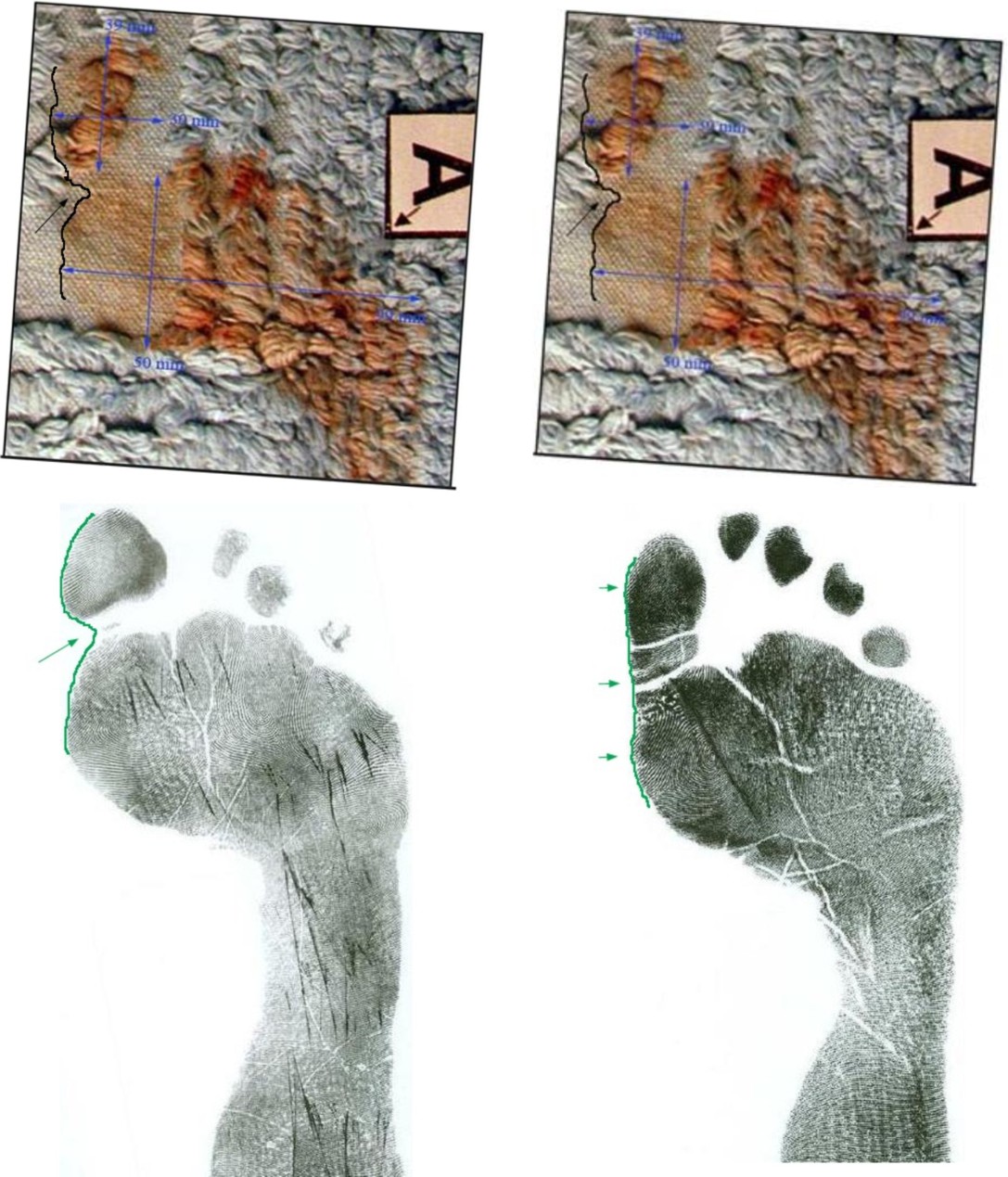
The “cleft” on the left side
This has a correspondence with one sample print, not so with the other.
29 . Table of metric comparison (by SomeAlibi)
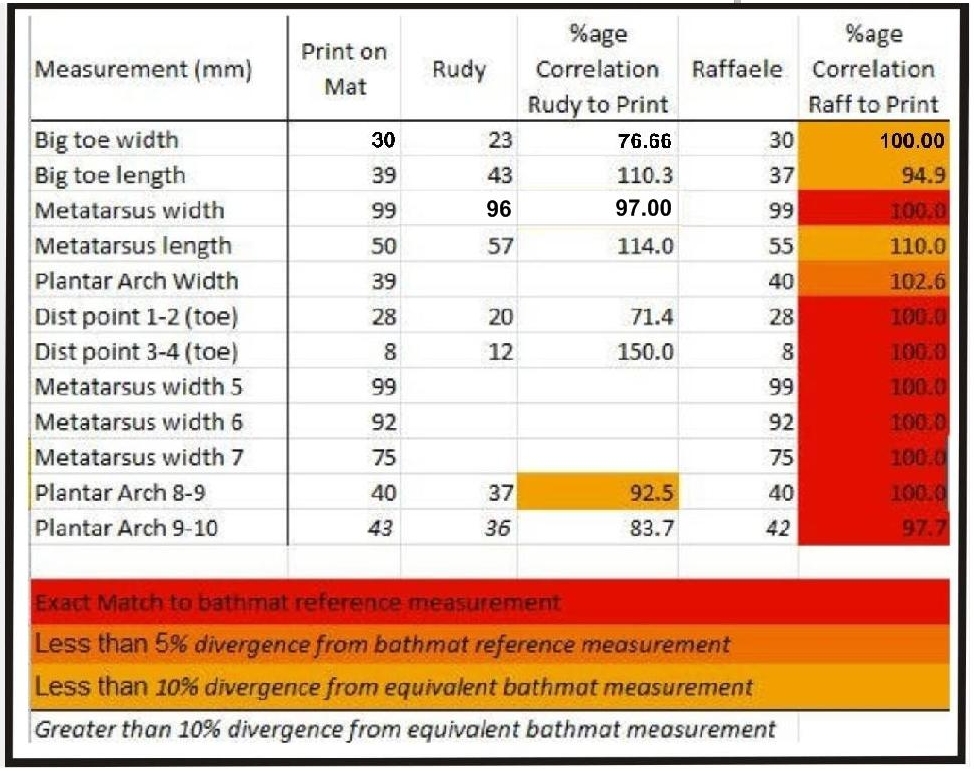
SomeAlibi’s post of a year ago
Comparison of measurements and analysis of correspondence degree of bathmat print, with both Guede’s and Sollecito’s sample prints.
Thursday, January 30, 2014
Appeal Session #10: After Defense Remarks Panel Of Judges Reaches Its Decision: BOTH GUILTY
Posted by Our Main Posters
Verdict: Both are confirmed guilty
The Massei verdict is upheld. The sentences are 25 years for Raffaerle Sollecito and 28.6 years for Amanda Knox. Sollecito is to have his passport taken away.
For Knox they could issue a worldwide Interpol Red Notice for immediate arrest around the world, even before going for extradition, to stop her dishonest self-serving blabberings.
Take a look at our conjectures down the bottom of this post on the judges’ deliberations. Looks like we got One, Two and Four right and Knox will be named in the judges report as the prime instigator.
That will hardly help her resist extradition. And it will please Guede and Sollecito, who both always hint at that.
To CNN: yet again this is NOT double jeopardy. Read the extradition treaty. It was ONE valid trial (2009) and now ONE valid and failed appeal (2014). Not two trials.
Tweets from our main poster Machiavelli
26. All these many thanks are so warming and comforting; I’m glad my contribution was useful among the many others.
25. No measure taken for expatriation of Knox because she is a US citizen currently in her own country.
24. Passport withdrawn for Sollecito and movement restriction within the boundaries of the state of Italy. No restriction for Knox.
23. Ruled that Knox’s royalties belong to Lumumba,
22. Accessory penalties/settlements: established Knox stinks, ordered Dalla Vedova to change jobs… (!)
21. Her calunnia sentencing has been increased from 3 years (Hellmann-Zanetti) to 3 years and 6 months.
20. To be more precise: Knox has been sentenced to 28 years and 6 months. (She has already served four years).
19. Massei sentence confirmed (25y), Knox sentence increased to 28 years because of calunnia aggravation
18. Bongiorno very agitated
17. Five minutes and a half from a verdict?
16. Judge declared the verdict will be 3D and distributed goggles [?]
15. Sollecito was in the courtroom. Appeared nervous.
14. Said because of the greatness of their power they should acknowledge reasonable doubt.
13. Ghirga emphasized discretional power of the court. Said they have big power to acquit.
12. In point of law: Ghirga said evidence must be considered as a whole in compliance with SC, but assessment should find reasonable doubt
11. Said no blood on knife because of negative TMB and blood confirmatory tests.
10. Ghirga: cited the claims about picograms, said amount is not the point, the problem is test repetition and other conditions
9. Says bruise at back of head is compatible with frotal fight against single aggerssor (disagreement with Introna on this too)
8. Ghirga: Meredith’s blue sweater was removed before fatal stabbing, as for Torre’s opinion. Admitas he disagrees with Sollecito’s defence.
7. Ghirga talked about: Meredith’s blue sweater, an echimosis at back of her head, DNA laboratories and Stefanoni’s quantization
6. Ghirga recalled a small number of details of physical evidence and autopsy.
5. Dalla Vedova asked acquittal, did not specify, whereas Ghirga instead, talking later, invoked reasonable doubt.
4. D.V. says believes there are other Supreme Court rulings in his favor.
3. D.V. emphasized the single pieces of evidence should be assessed each one in parceled out, atomized way before considering the whole
2. DV focused on evidence assessment procedure, quoted SC rulings.
1. Dalla Vedova’s talking lasted a short time, and not very orderly.
Tweets from reporter Barbie Latza Nadeau
28. Court: Amanda Knox Is Guilty. See more in The Daily Beast.
27. Kercher family members being briefed by lawyers and British consulate.
26. Sollecito must surrender all documents, passports, identification,
25. Its 25 years for sollecito and 28.6 years for amanda knox
24. Amanda Knox [2009] guilty verdict upheld, sollecito [2009] guilty verdict upheld.
23. Judges and jury enter.22. Huge security presence ahead of verdict including riot police outside and in public area of courtroom amandaknox tense
21. meredithkercher sister stephany and brother lyle have arrived in court for verdict.
20 Prosecutor Crini has arrived in court for verdict in amandaknox appeal
19. Clerk says between 9-930 local time judges will return. Says judges want “utter silence no shouting or clapping”
18. Court clerk says verdict will be delivered between 9 and 9:30 tonight.
17. Amanda Knox “˜Afraid’ Of Today’s Court Verdict http://thebea.st/LeteHD via @thedailybeast
16. Court clerk says at 8pm she will go back to judge to find out if and when they are ready to deliver verdict.
15. Court clerk says “presumably verdict at 8:00 but everyone come back at 7:00
15. Court clerk just announced that at 6pm local they will tell us when the verdict will be announced.
14. Mario Spezi, author of Monster of Florence, has come to court to hear amandaknox verdict.
13. Lawyers for amandaknox and sollecito, journalists already in courtroom ready for verdict that come come any time from 5pm Florence time.
12. Lunch has just been brought in to judges and lay jury deliberating amandaknox case. No wine.
11. Refreshments just delivered to jury members in amandaknox new appeal, espresso, cappucino and possibly a tea…
10. Judge in amandaknox new appeal says decision will not come before 5pm.
9. amandaknox lawyer asks court to absolve his client.
8. amandaknox lawyer says the dna on the knife attributed to meredithkercher can not be verified, can not be considered.
7. amandaknox lawyer Ghirga tells court they have to look at all the evidence to reach verdict, not value pieces here and there.
6. amandaknox lawyer says you can’t put two innocent people in jail to cover up mistakes of judicial system.
5. amandaknox lawyer tells judge: you cannot convict for murder in the name of Italy when evidence is ‘probably’ attributed to a defendant.
4. amandaknox lawyer says you can’t cancel out evidence, says Amanda’s rights were violated, she was in shock when she accused Lumumba.
3. sollecito in court by his dad who said they are all nervous for verdict over drinks with journalists at hotel bar last night.
2. amandaknox lawyer CDV says they are serene going into verdict because they believe in her innocence,
1. Court in session. One of the jurors wearing a shiny spangled skirt, rest dressed soberly.
Tweets from Freelance Reporter Andrea Vogt
13. Meredith Kercher’s brother: It was the best we could have hoped for, but amanda knox verdict not cause for celebration.
12. amanda knox guilty verdict upheld. Her lawyer Carlo Dalla Vedova said he has called her. She did not cry. She was “petrified.”
11. amanda knox conviction upheld. sentenced to 28 years and six months. Sollecito to 25. Ordered passports to be taken.
10. Meredith’s sister and brother are accompanied by British consulate officials. A hush has come over the courtroom.
9. The family of meredith kercher has arrived in court to hear the verdict.
8. Even most experienced Italian court reporters not predicting what long wait for amanda knox verdict means. Could go either way
7. amanda knox verdict is expected at 9 or 9:30. Clerk reminds about the decorum expected:no applause, shouting, cheering, etc
6. Standing room only in Florence court as media, legal teams, public await amandaknox verdict (timing soon to be announced).
5. Judge and jury in amandaknox case have retreated for deliberations. Verdict not before 5 pm Italy time.
4. amandaknox Judge : we will not give a verdict before 17, after that,can come any time, but will announce with lots of advance notice.
3. Ghirga: We wait anxiously and seriously for justice for Meredith. But doing justice means doing it also for amandaknox and RS.
2. amandaknox lawyers are in court. Ghirga: “siamo fiduciosi, serene, emotionati.” (Roughly: “Trusting, calm, on edge”).
1. Verdict expected late today in amandaknox appeal….
Freelance Reporter Andrea Vogt On Website
From The Freelance Desk
Amanda Knox is expected to wait out the verdict in her appeal at her mother’s Seattle home (likely with American television news networks present) while Raffaele Sollecito was in court with his father and a friend. Sollecito made no remarks upon leaving for the courthouse in a taxi, surrounded by a pack of cameras. Meredith Kercher’s sister, Stephanie, and brother, Lyle, are also expected in Florence today for the court’s decision, expected in the evening hours….
Conjectures on what the judges may be discussing
The panel of judges is in effect deciding now on positions that must be sustained in 2-3 months in a 100-400 page document that must be okayed by the Supreme Court.
This might be what the quite long (by Italian standards, they will have discussed the case intermittently) jury discussion today is focused upon. Here are four possible issues.
Possible issue one
As sharp Italian media are pointing out, Prosecutor Crini departed from the Massei scenario and suggested a different driver in one key respect.
Like Mignini and Micheli in 2008 he assigned the role of prime mover to Amanda Knox and not to Guede. (Nobody ever assigned it to Sollecito.)
Maybe hoping to give RS and AK a break the Massei jury (not neccessarily the judge himself) assigned to Guede the primary role in starting the attack, saying maybe he forced himself upon her.
Then maybe the other two came in from next door, and set about helping him to subdue Meredith.
They just happened to have two knives handy, and even Massei assigns the fatal blow to Knox.
Crini argued as more likely that Knox started to quarrel with Meredith over hygiene or drugs or money and the other two joined in and for 15 minutes the attack escalated.
In this Knox and not Guede is assigned the role of prime mover.
The judges may want to accept this and seek to assign Knox a harsher punishment accordingly.
(Neither court seems to have settled on a convincing reason for why the big knife was brought down from Sollecito’s house which looks to us at minimum forboding.)
Possible issue two
This relates to the scenario in the comment above. Judge Massei lopped five years off the routine sentences by conjuring up “mitigating factors”.
One such factor was the duvet placed over Meredith which Massei thought could be a sign of remorse, surely by a woman.
Many including psychologists never agreed with this. It could have been simply an aversion to all the blood, which Knox on the stand in 2009 chillingly described as “yucky”.
If so the sentences awarded could creep up beyond the durations decided on by Massei. Above 25 and 26 years.
Possible issue three
This is an alternative to One and Two above. The judges might think the crime was more like a manslaughter, an attack that ended in murder
But not intended as such and never agreed to by two of the attackers. In which case sentences could be a lot lighter.
Possible issue four
There are financial award considerations. How much to award to whom, plus maybe ways to ensure their payment in light of Knox blatantly stiffing Patrick..
[Below: image of the judges and lay judges arriving this morning]
